भौतिकी वर्ग
| PHYSICS GROUP | Jane Alam | |
| Experimental Nuclear Physics Division | Jane Alam | |
| Nuclear Electronics Section | Lekha Mandal Chowdhury | |
| Cryogenic Trap Section | Parnika Das | |
| Nuclear Structure Section | Sarmistha Bhattacharyya | |
| Nuclear Reaction Section | Kaushik Banerjee | |
| Theoretical Nuclear and Many Body Physics Division | Sourav Sarkar | |
| Nuclear Dynamics and Nuclear Astrophysics Section | Gargi Chaudhuri | |
Theoretical Physics
Overview
The nuclear theory group at VECC is engaged in exploring nuclear dynamics at energies extending from low to extreme relativistic energies. At a microscopic level, an effective Nucleon - Nucleon interaction is used to investigate nuclear processes such as proton and alpha-decay rates and also nuclear properties like nuclear equation of state. Cross sections of photonuclear reactions and neutron induced reactions are calculated. Fission dynamics of hot and rotating compound nuclei are studied extensively using Langevin equations. Neutron multiplicities and evaporation residue cross-sections from fusion-fission reactions are systematically investigated in order to find the magnitude of nuclear dissipation. At intermediate energies nuclear multi- fragmentation becomes the dominant process for which statistical methods are exploited. Nuclear properties such as symmetry energy are being investigated by comparing the predictions of the statistical model with experimental data.
A new state of matter called quark gluon plasma (QGP), that existed shortly after the Big Bang may be created by colliding heavy ions at ultra-relativistic energies. QGP is believed to be the most perfect fluid ever discovered. Members of the theory division, VECC, are actively engaged in dynamical modelling of relativistic heavy ion collisions to understand the important issues like, initial conditions, thermalisation, equation of state, transport properties etc. Effects of viscosity on several experimentally measured quantities like elliptic flow and transverse momentum distribution of hadrons and photons are investigated by evolving heavy ion collisions in space and time using relativistic hydrodynamics. Works on the systematic of photon and dilepton productions in ultra-relativistic heavy ion collisions including Hanbury Brown Twiss intensity interferometry with electromagnetically interacting particles are being pursued rigorously. The elliptic flow of the matter produced in nuclear collisions at relativistic energies probed by real photons and lepton pairs are shown to be an effective technique for the detection of QGP. In addition, the role of heavy quarks in probing the properties of QGP is examined in detail. Investigation of hadronic properties in hot and dense matter using effective theories of strong interaction constitutes another important sphere of activity in the theory division. In particular, the spectral properties of light vector mesons, nucleons and pions are evaluated at non-zero temperature and baryon density using thermal field theory and its effects on the photon and dilepton spectra are investigated.
Collaborations
Research
Dynamical and statistical models of nuclear fission:
Langevin equations are employed to study the dissipative dynamics of highly excited compound nuclei undergoing fission. A microscopic model of nuclear dissipation is developed.
The statistical model is used to study systematic features of fission including photo-fission cross-section.
Dissipative fluid dynamics in relativistic heavy ion collisions:
Space-time evolution of a dissipative fluid modeling a strongly coupled quark-gluon plasma and undergoing boost-invariant longitudinal and arbitrary transverse expansion is formulated from Israel-Stewart’s formal theory of 2nd order dissipative fluid dynamics. A computer code AZHYDRO-KOLKATA is developed to solve these equations to study the fluid properties.
Quark Gluon Plasma diagnostic: J/psi suppression in nuclear medium:
J/psi suppression in nuclear collisions at SPS (Ecm~18 AGeV) and RHIC (Ecm~200 AGeV) energies is studied and its role as a quark gluon plasma diagnostic evaluated.
Thermal Radiations from Relativistic Heavy Ion Collisions:
Radiation of thermal single photons and dileptons from relativistic heavy ion collisions at SPS (Ecm ~18 AGeV), RHIC (Ecm~200 AGeV), and LHC (Ecm~5500 AGeV) energies and their role as a signature of quark-hadron phase transition is studied.
The intensity interferometry of thermal photons is studied with a view to get information about the evolution of the system formed in such collisions.
Electromagnetic Radiations from Quark Gluon Plasma due to Passage of Jets:
Suppression of particles having large transverse momenta due to the energy loss suffered partons during their passage through quark gluon plasma, known as jet-quenching is one of the most spectacular observations at RHIC energies. First studies of radiation of high energy photons and large mass dileptons due to the passage of high energy partons through quark gluon partons are performed.
Elliptic Flow of Thermal Photons and Thermal Dileptons in Relativistic Heavy Ion Collisions:
Elliptic flow of hadrons radiated from relativistic heavy ion collisions are considered to be a most reliable confirmation of the formation of a hot and dense system very early in the collision. However, the hadrons themselves leave the system at the time of freeze-out. First studies of the elliptic flow of thermal photons and dileptons are performed with a view to get direct information about the evolution of the elliptic flow and the flow of the quark gluon plasma stage of the system.
Parton Cascade Model for Relativistic Heavy Ion Collisions:
A description of the relativistic heavy ion collision is attempted in terms of scattering, radiating, and fusing partonic cascades, based on perturbative quantum chromodynamics. Energy densities, Debye screening lengths, and radiation of pre-equilibrium photons from such studies is performed.
Stochastic Processes:
The perturbed angular correlation between the two gamma rays is investigated in terms of the transport properties of the environment. The role of stochastic resonance in information transmission through noisy channel is being studied. Application of the coherent stochastic resonance phenomenon to separate different sizes of large DNA molecules is under investigation.
Properties of nuclear matter and nuclear processes in finite nuclei
Mean field calculations are made for the properties of nuclear matter. Microscopic calculations of nuclear potentials are also made to extract the particle and cluster radioactivity lifetimes of finite nuclei.
The liquid drop mass formula is extended to estimate the binding energies of hyperons and also to predict the existence of bound hypernuclei near the drip lines.
Propagation of partons through quark gluon plasma and jet quenching
Medium modification of production of hadrons in relativistic heavy ion collisions due to propagation of quarks and gluons through quark gluon plasma undergoing multiple collisions and radiating gluons before fragmenting is studied to understand the phenomenon of jet quenching.
Nuclear multifragmentation in intermediate energy heavy-ion collisions
Thermo-dynamical models based on both canonical and grand canonical ensembles are being developed in order to study multifragmentation in intermediate energy heavy ion collision. The model is also suitably extended for the projectile fragmentation reactions (peripheral collisions). These models are used to study the systematic features of multi-fragmentation like mass and charge distribution, isotopic distribution, multiplicity of intermediate mass fragments and others. Isospin dependence is also being investigated.
Experimental Nuclear Physics
Overview
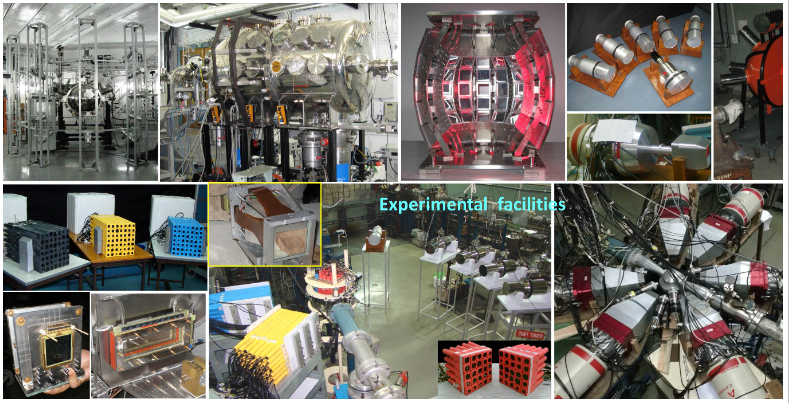
Even after almost one century of its discovery, the atomic nucleus still remains enigmatic! The nucleons in the nucleus are strongly bound, and therefore the nucleus is very reluctant to reveal its secrets so easily. It has to be hammered hard to break into its solid defense – and that is exactly what the experimental nuclear physicists try to do all the time – hit it hard with ‘energetic’ projectiles (light ions like proton, He++ as well as heavy ions like O6,7+, Ne7,8+, etc. ) , detect the observable ‘bruises’ of the collision with innovative ‘detectors’, and interpret the result to find out the secrets of the nucleus.
At VECC, such studies are being carried out for the past three decades using K130 cyclotron. Main research areas covered with K130 cyclotron are: Elastic and inelastic scattering, direct and pre-equilibrium reactions, fusion-fission dynamics, intermediate mass fragment emission, nuclear orbiting/quasi-molecular resonance, gamma-ray spectroscopy and nuclear structure, giant resonance, nuclear Bremsstrahlung, resonance particle spectroscopy, external modification of nuclear decay rate, etc.
We are currently at the doorstep of opening another new and exciting chapter! As soon as the new K500 superconducting cyclotron (typical beam energy ~ 5 – 50 MeV/nucleon or more) is operational, it will open up new and challenging opportunities for carrying out pioneering research in the areas of current interest (i.e., hot nuclei, multi-fragmentation and nuclear liquid-gas phase transition, giant resonances, collectivity and temperature, isospin physics and nuclear equation of state, structure of particle unbound resonances, structure of exotic nuclei etc., to mention a few. Presently, several new, large, state-of-art detector systems and general users’ facilities such as Segmented Horizontal Axis Reaction Chamber (SHARC), 4-pi charged particle detector array, Large Area Modular BaF2 Detector Array (LAMBDA), 4-pi neutron multiplicity detector, neutron time-of-flight detector array, ion trap, etc are being developed (some of them are already commissioned, others are nearing completion) by VECC under the aegis of superconducting cyclotron utilisation project. In the next phase, these detector systems will be augmented with the addition of new features.
Collaborations
Indian National Gamma Array (INGA) Collaboration :
Indian National Gamma Array (INGA) is an array of state of art new generation Compton suppressed Clover HPGe detectors, which is a collaborative national project in India for nuclear structure studies using high resolution gamma ray spectroscopy. Variable Energy Cyclotron Centre has taken one of the leading roles in implementing this project among three accelerator centres in India. INGA project is collaboration among the national institutes, viz., Variable Energy Cyclotron Centre (VECC), Kolkata, Tata Institute if Fundamental Research (TIFR), Mumbai, Inter University Accelerator Centre (IUAC), New Delhi, Saha Institute of Nuclear Physics (SINP), Kolkata, UGC-DAE-CSR, Kolkata Centre and other universities.
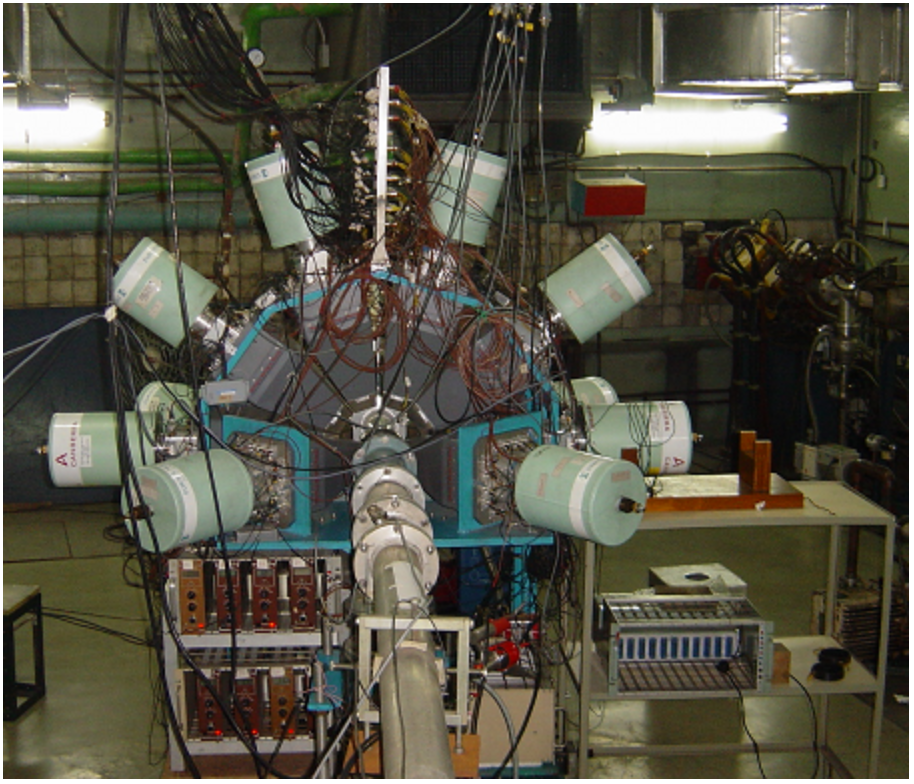
At VECC, Kolkata, the first campaign of INGA took place in 2005 with 10 Compton suppressed Clover HPGe detectors, to explore the physics possibilities with beams of heavy ions of higher energy (~7-8 MeV/n). The energy regime of the beams from ECR ion source was unique which allowed population of nuclei at higher angular momentum using non-equilibrated reaction mechanisms. In this campaign, in addition to the Clover detectors, 2 segmented Planer HPGe detectors, called Low Energy Photon Spectrometer (LEPS), were also added to the INGA setup for tagging of X-rays and to maximize the efficiency of detection of low energy gamma rays below 100 keV. The pictures of this setup at the beamline of K-130 cyclotron is shown in the figure.
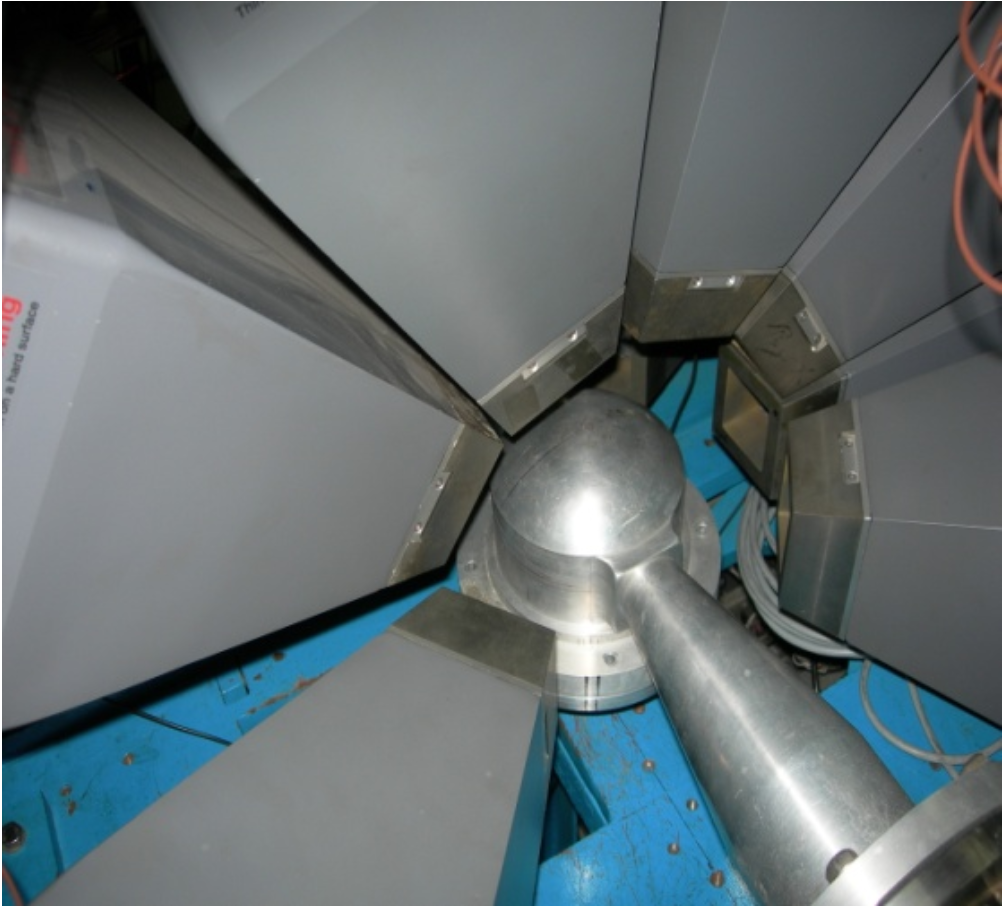
Research
Change of electron capture nuclear decay rate in different environments
Is it possible to change the decay rate of a radioactive substance by external means such as pressure, temperature, chemical environment etc.? The answer given in the text books is “No”. However the electron capture radioactive decay(meaning the capture of an orbital electron by the nucleus) should be slightly affected by the external environment. The electron capture decays taking place deep inside massive stars are expected to be faster than observed terrestrially. Perhaps such decays taking place deep inside the earth are also faster than we normally see. At VECC, we are studying the change of electron capture decay rate of 7Be, 109In, 110Sn etc. under pressure and in different chemical environments to learn about such effects. We compressed large radioactive atoms such as 109In, 110Sn etc. by implanting them in a small lattice and recently observed about 1% increase of decay rate.
Nuclear Orbiting Reaction
It is well-known that the nuclei fuse to form a compound nucleus, if they collide with sufficient kinetic energy to overcome the Coulomb barrier. However occasionally in some cases, instead of fusing, the two nuclei form a quasi-bound dinuclear system which would preferentially break apart into the entrance channel without ever undergoing complete fusion. It is generally assumed that the thermal equilibrium of the dinuclear orbiting complex is achieved quickly, but still the two nuclei would maintain their identities inhibiting their fusion.
Nuclear orbiting means that the two nuclei instead of fusing have formed a quasi-bound dinuclear system which would preferentially break apart into the entrance channel without ever undergoing complete fusion. It is generally assumed that the thermal equilibrium of the dinuclear orbiting complex is achieved quickly, but still the two nuclei maintain their identities and their complete fusion is inhibited.
In the literature, the words “Nuclear orbiting reaction” had been used for the last 30-35 years to describe different observed anomalies of nuclear reactions (in the projectile energy region 3-8 MeV/A) that could not be explained by standard statistical model calculations. Usually whenever the observed yields of the emitted fragments were found to be higher than those expected from the standard statistical model calculations or the observed width of the mass distribution of the fragments was found to be wider than that expected from the statistical model calculation, the qualitative idea of nuclear orbiting was invoked in one way or the other. On the other hand, the believers of the statistical model (Moretto and others) tried to show that most of these observations can be explained by adjusting the parameters of the statistical model, using more elaborate statistical model codes and by simple extension of the statistical model, without requiring this idea of orbiting. There was also the question regarding the fundamental difference between a highly deformed rotating compound nucleus and an orbiting complex formed in the entrance channel. Of course, in the exit channel, there is no difference between the two, as the final breakup must be from a dinuclear system.
We differentiate between the formations of an orbiting complex and deformed spinning compound nucleus in the entrance channel by observing entrance channel dependence of the emitted fragments when the same composite is formed by two different reactions at the same excitation energy with very similar spin distributions. At the same time, we also ensure that the reaction mechanism is not a simple direct reaction by observing 1/sinqc.m angular distribution at the back-angles, which should mean the formation of a long-lived intermediate complex. If we find entrance channel dependence (preferential breakup into the entrance channel), in addition to 1/sinqc.m angular distribution at the back-angles, then we consider the formation of an orbiting complex in the entrance channel. Otherwise it should be a compound nucleus in the entrance channel. Using these criteria, it has been found that only a few systems such as 24Mg+16O, 28Si+12C, 16O+89Y, 16O+93Nb (at projectile bombarding energy 4-8 MeV/A) form orbiting complexes at high orbital angular momenta (near the critical angular monetum) and preferentially break apart into the entrance channel. Although a theoretical understanding of the process is still lacking, we are experimentally studying the temperature and the decay process of the orbiting complexes and highly deformed spinning compound nuclei.
Fragments emission studies in light Heavy-ion collision
Study of fragment emission mechanisms for light heavy-ion (Aproj.+ Atarget < 60) collisions, at energies (<10 MeV /u ) is subject of great interest in the recent years. The origin of these fragments extends from quasi-elastic, deep-inelastic transfer and orbiting, to fusion–fission processes; and in some cases the structure of the nuclei has been found to play an important role. Many interesting features, e.g., quasi molecular resonance, super deformed bands, orbiting etc. have been seen for nuclear reactions involving alpha like nuclei. Although, there is no apparent link between these phenomena, they are believed to originate from highly deformed configuration of these systems. The occurrence of such highly deformed configurations and their evolution with excitation energy are studied at VECC through charged particle spectroscopy.
Gamma Ray Spectroscopy
Many of the secrets of an atomic nucleus, a tiny object but a potential source of huge energy, can be understood by putting it under “extreme conditions” and studying how it survives such a stress. Gamma ray spectroscopy is one of the powerful tools for such study and to “visualize” the shape and shell structure of a nucleus. The “extreme conditions” of large isospin (neutron-proton asymmetry), high excitation and large angular momentum are achieved in a nucleus by producing them in a variety of direct and indirect nuclear reactions using energetic beam of particles from an accelerator. The gamma rays, emitted from the produced nuclei, carry the information of the shape of a nucleus and the quantum states of the protons and the neutrons inside it. These gamma rays are detected using several high resolution, state-of-the-art, Hyper Pure Germanium (HPGe) Detectors. Several ancillary detectors for detecting charged particles, neutrons and to measure gamma multiplicity are also used in conjunction with the HPGe detectors to achieve better sensitivity. Several such experiments have been performed using the experimental facilities at VECC, at BARC-TIFR Pelletron, Mumbai, Inter University Accelerator Centre, New Delhi and also at various facilities abroad. In these experiments, combined with nuclear model calculations, we try to understand the new symmetries in nuclei (manifested in tetrahedral shape, chiral bands, magnetic rotation etc.), the change in shell structure in extremely neutron rich nuclei, shape change and shape coexistence in nuclei, formation of high spin isomers in nuclei, etc.
Resonance Particle Spectroscopy
Resonance particle spectroscopy is a quite powerful technique in nuclear physics to study the space-time characteristics of particle emission mechanism in nuclear reactions. This is a unique tool to study the structures and properties of the particle-unbound resonance states in nuclei by detecting their decay products in coincidence. One of the major research goals of the charged particle detector array, is to carry out systematic resonance spectroscopy studies of (a) the alpha-cluster structure of light alpha-like nuclei using K130 cyclotron and other accelerators in India, and, (b) the structures of exotic particle-unstable resonances of stable nuclei and nuclei away from alpha-stability line, which will be produced in intermediate energy nuclear reactions using K500 superconducting cyclotron. Recently, studies on 2-alpha structure of 8Be, and 3-alpha structure of Hoyle state of 12C, have been carried out. Hoyle state of 12C is specially interesting as it is claimed to be either a 3-alpha-chain structure or a gas-like condensate. Our new measurements are expected to throw new light on the structures of these resonances.
Study of the Fusion-fission and Quasi-fission Dynamics
We have an active research program to explore the role of entrance channel on fusion-fission dynamics.
One of the major aspects of today’s nuclear physics research is to look for the dynamical effect which inhibits the fusion process. These studies are important since they give a clue for picking up the right kind of target and projectile combination for the formation of super heavy elements (SHE). A comprehensive study of fission fragment mass and angular distribution at near barrier energies was embarked on for heavy ion induced fission reactions experimentally, to have an insight of the dynamics of the fusion-fission reactions. The experiments are carried out with pulsed heavy ions from the accelerators (IUAC Pelletron, New Delhi, BARC-TIFR Pelletron, Mumbai, VECC Cyclotron, Kolkata) available in India using the detectors developed indigenously in the laboratory. For the first time, a direct evidence of orientation dependent quasi-fission reaction was established. A novel and powerful tool to look for the onset of a non-statistical reaction mechanism in heavy ion induced fission was unearthed.
High Energy Photon Spectroscopy
Hot nuclei are formed in heavy ion fusion reaction where the relative kinetic energy of the colliding nuclei is converted into internal excitation energy and high angular momentum of the compound nuclei. These systems are unstable and decay by emission of particles (neutron, proton, alpha-particle, etc.) and heavier fragments. Apart from particle emission, the system can also decay by emitting gamma-rays. The decay of Giant Dipole Resonance (GDR) is one of the way through which the energy is released from the system in the form of electromagnetic radiation (8-20 MeV).
Giant Dipole Resonance: It corresponds to a collective motion involving almost all the particles in the nucleus. It can be viewed as small amplitude, out of phase vibration between the protons and the neutrons. The high-energy decay of GDR built on excited state provides us a unique tool to study the diverse properties of the nucleus at extreme conditions.
>Temperature & angular momentum dependence of the intrinsic GDR width.
> Nuclear shapes at extreme conditions via GDR lineshapes.
> Loss of collectivity, existence of a limiting temperature for collective motion in nuclei.
> Influence of the lifetime of the CN on the observed GDR width.
> Probing the time scale for thermal fluctuations and the validity of “adiabatic picture”.
> Dissipative fission dynamics.
Nucleon – Nucleon Bremsstrahlung: Nuclear bremsstrahlung (> 20 MeV) is released during the first stages of the nuclear reaction in which the nucleus is not equilibrated, allowing one to probe the nucleon-nucleon interaction and the dynamics of nuclear reactions. These high-energy g-rays help in understanding the early states of the nuclear reaction.
> Nuclear medium effects.
> Collision dynamics.
Facilities
Large, Segmented, Horizontal Axis, Reaction Chamber (SHARC) ...
This large, segmented, horizontal axis, reaction chamber (SHARC) is integrated with the beam line in the VECC superconducting cyclotron (SCC) experimental area. It is a cylindrical, three segment, stainless steel chamber of length 2.2 m, diameter 1 m and wall thickness ~10 mm; the front (beam-entry) end is hemispherical in shape having a radius 500 mm and the rear end is elliptical dish (2:1) shaped. Inside SHARC, there are two pairs of parallel rails to put a target ladder and a generalized detector mounting table. The whole target assembly can be placed anywhere on the rail with vertical and rotational movement facility controllable remotely. The generalized detector mounting table has precision alignment mechanism on manually movable stands with a locking arrangement. There is no rotating arm inside; users are encouraged to fabricate their own detector stands as per requirement. The vacuum (in empty chamber) ~1X10-7 mbar is obtained in 10 hrs by means of two turbo molecular (1000 litre/sec) and two cryo pumps (2500 litre/sec) backed by mechanical pumps.
Large, Segmented, Horizontal Axis, Reaction Chamber (SHARC) ...
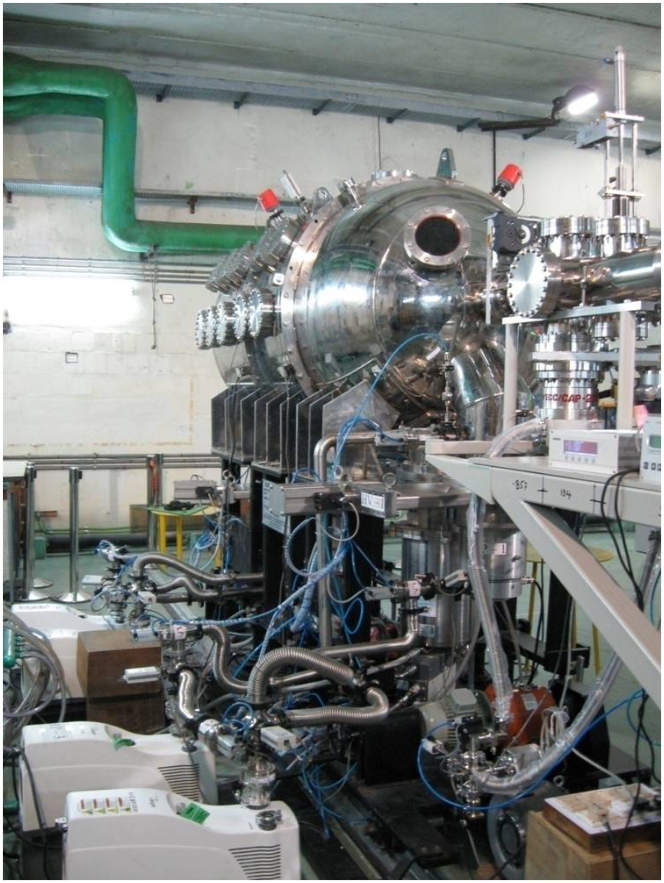
Neutron Multiplicity Detector
Nutron Multiplicity Detector constitutes a powerful means for the nuclear temperature measurements. It allows to measure, event by event, with high efficiency, the number and total kinetic energy of neutrons emitted in a nuclear reaction. This detector has been developed first time in our country. NMD consists of two stainless steel hemispheres of one metre diameter, filled with 500 litres of 0.5% Gd loaded liquid scintillator BC521. This development involved many sophisticated subsystem developments like, pumping system for liquid scintillator, scintillator testing setup and readout electronic, etc. One of the important characteristics of the above detector is the capture time distribution, which depends on the quantity of the Gd doped in the liquid sctillator.
Neutron Multiplicity Detector
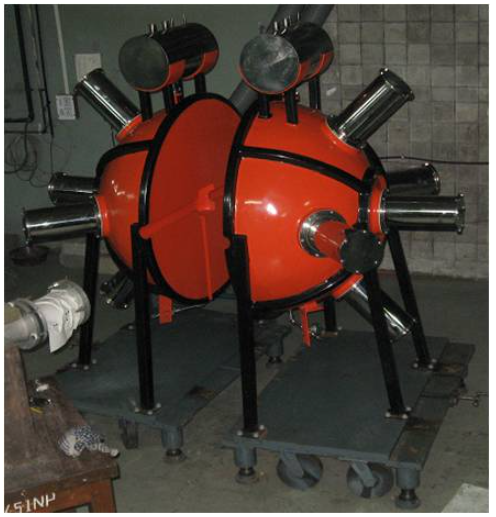
Neutron Detectors for Time of Flight Measurement
To boost up the experimental nuclear physics research in the country, several detector arrays were planed at VECC under the super conducting cyclotron utilisation project, neutron Time OF Flight (TOF) array is among one of major system. Neutron TOF array has been developed for the precise measurement of neutron energy and angular distribution. The array consists of 50 numbers of neutron detectors, each having 5" diameter and a similar length. Detectors are liquid scintillator based and have been indigenously designed and developed at VECC, after long, involved and careful R & D effort. The primary motivation of the array is to look for answer of the some of today's frontline nuclear physics problems, understand the fission dynamics at near barrier energies, measurement of nuclear level density parameter, multi-fragmentation, exotic fragment studies, etc.
Neutron Detectors for Time of Flight Measurement
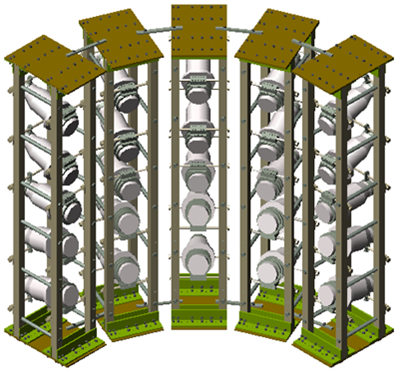
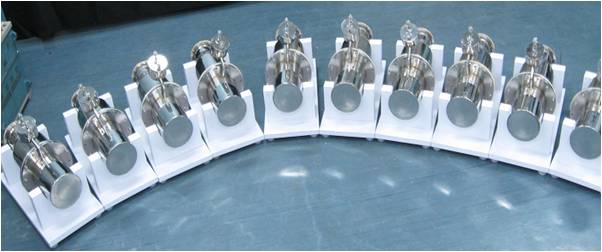
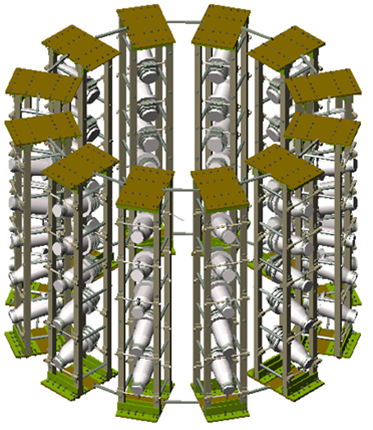
Large Area Modular BaF2 Detector Array (LAMBDA)
It is a high energy photon spectrometer, complete with its dedicated front end electronics & data acquisition system.
LAMBDA is the acronym of Large Area Modular BaF2 Detector Array, developed to study the high energy gamma rays, coming from hot composite systems produced during heavy ion collisions. These photons are emitted at very early stages in the evolution or decay process of the hot compound system and can be efficiently used as a tool to study the diverse properties of hot and fast rotating nuclei.
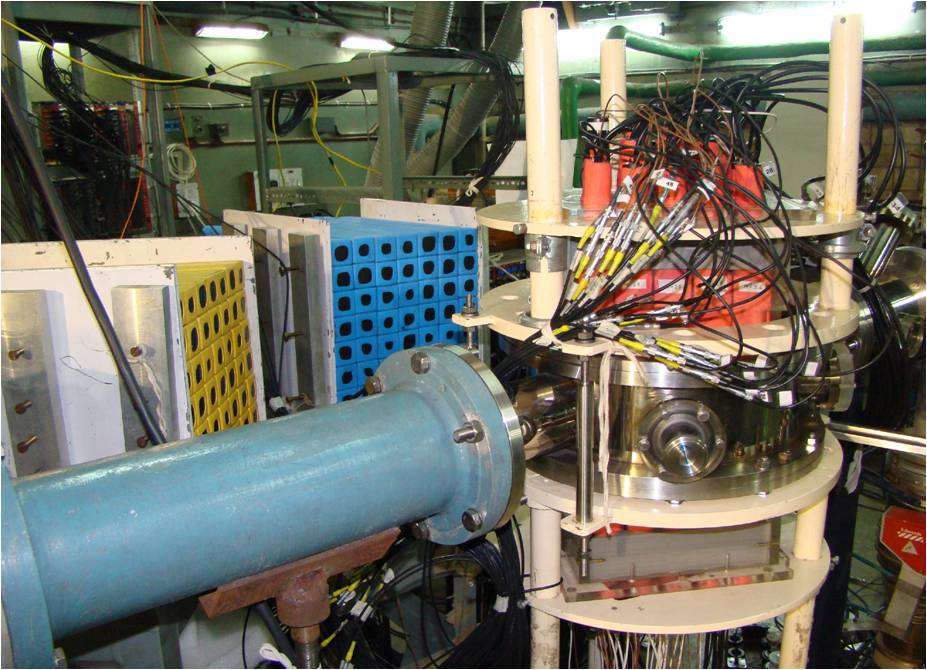
Barium fluoride (BaF2) crystal is a very fast scintillator with a high gamma detection efficiency. Therefore, it is the ideal choice for a high energy photon spectrometer where time-of-flight technique is to be employed for efficient neutron rejection.
Array Features:
* 162 individual detector elements.
* Large gamma detection efficiency.
* Fast timing response (960 ps).
* High Modularity to allow different geometrical configurations depending upon the experimental requirements.
* Dynamic event reconstruction to reject cosmic muons and pile-up events.
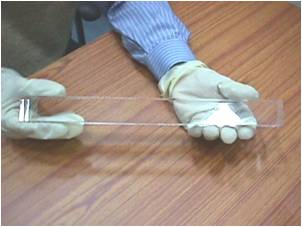
Each crystal has the dimension of 3.5 cm x 3.5 cm cross-sectional area and 35 cm long. The entire spectrometer was fabricated in house from the procured bare crystals.
Electronics & Data Acquisition
A dedicated electronics setup has been developed to register the energy and time information from each detector element in event by event mode. The latest commercially available high-density programmable CAMAC modules were used for its front end dedicated electronics. All electronics & DAQ were kept inside the experimental hall next to the array and were controlled from outside over Ethernet.
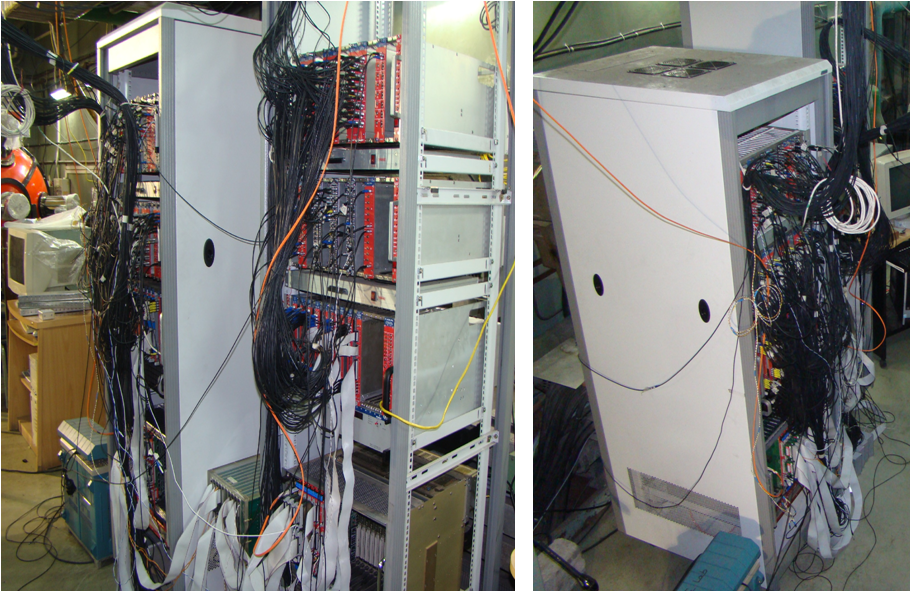
The DAQ associated with the array is based on VME platform in a LINUX environment. High density (32 channels), fast VME QDCs and TDCs have been employed for energy and time measurements. It is capable of handling typically ~4000 events per second without appreciable dead time loss.
Gas detector developement
At VECC, we have an active research program to develop gas detectors for detection of heavy charged particles. After an intensive R and D efforts, few position sensitive Multi-Wire Proportional Counters (MWPC) were designed and fabricated indigenously. These large area detectors (typical area is 20 cm x 6 cm) are proficiently used in experiments at the major accelerator facilities available in our country. The position resolution achieved with these detectors is better than a millimetre and time resolution better than a nanosecond. We have also developed avalanche counters (5 cm x 3 cm active area) that is efficient for ”start time“ measurement in a time of flight setup.
The Breskin type of low pressure multi-wire proportional counters detectors that we have developed consists of 5 wire planes. The central anode wire plane provides the time information. Position information (in both X and Y direction) are achieved by delay line method. Two cathode planes give the energy loss in the detector deposited by the charged particles.

For the assembly, fabrication and testing of gas detectors, we have a well equipped gas detector laboratory. We have developed a film stretching unit for the preparation of thin polypropylene foil used as the entrance window for the detectors. The front-end of the detector is usually covered by a polypropylene film that is required to be thin enough to minimize the energy loss of the detected charged particle. Thick polypropylene sheet (~ 20 micron) available in the market are stretched to less than a micron thickness by this film stretching unit. An aluminium plate, covered by teflon sheet are heated at about 60°C, be in a motion slowly upward by controlled pneumatic action. The plate stretches the polypropylene film mounted on a table.
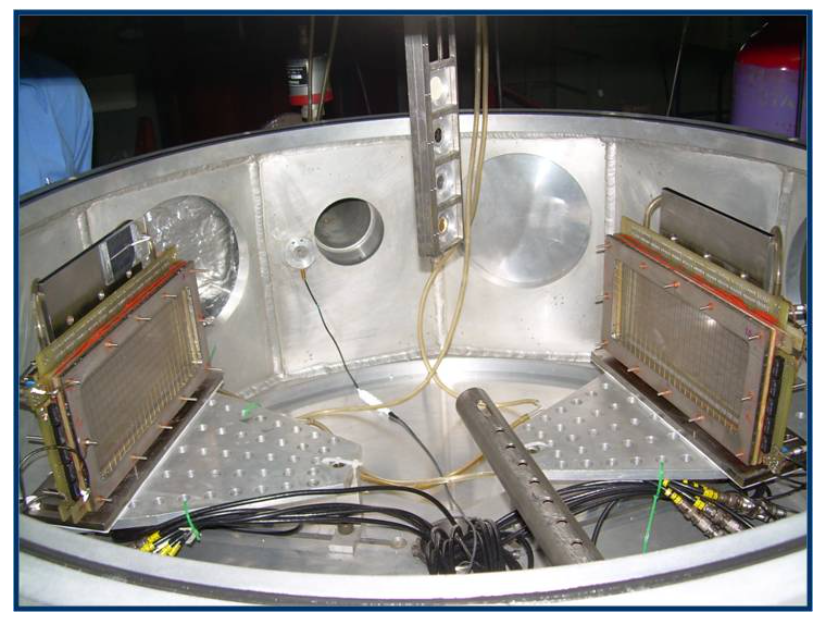
A time of flight setup inside VECC scattering chamber, with the two large area MWPCs developed at our laboratory. In the experiment, masses of the fission fragments were measured from the time of flight difference of the fragments.
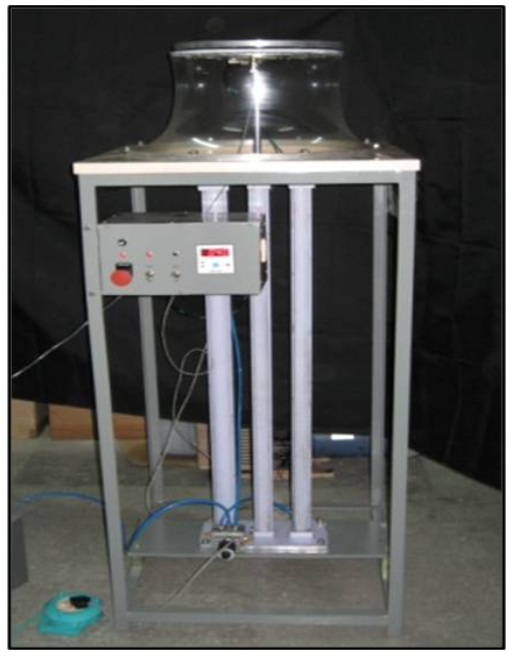
We have also developed our own gas handling system. The detectors are operated in flow mode at a typical pressure of 3 torr of isobutene gas. Since the window of the detector is very thin, it is compulsory that the initial pumping of the detector has to be done very slowly. Any fluctuation of inside gas pressure can tear down the window and thus needs precession flow control. We have designed a gas handling system for this purpose. It consists of a mass flow controller and an electronic valve that protects the window/detector even in case of power failure during experiment. The mass flow controller offers automatic maintenance of the inside gas pressure very accurately.
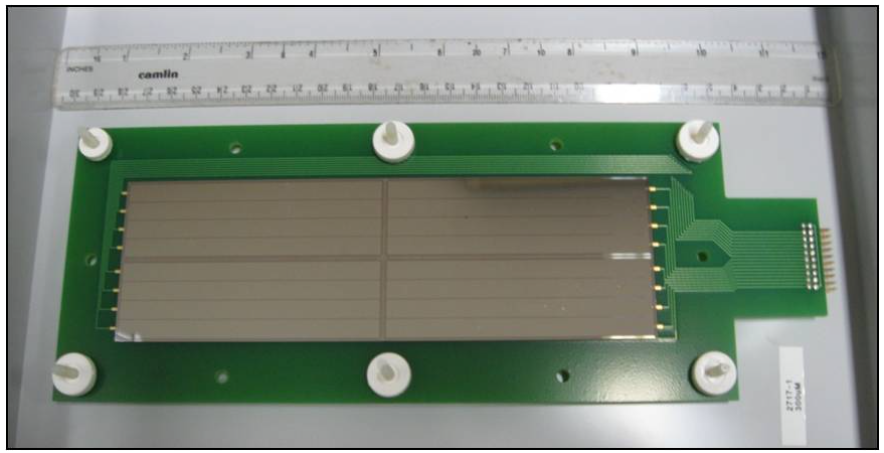
A 16 segment silicon detector which is used as the back side of the hybrid gas detector that provides time, position and energy info of a charged particle.
In our country, in next few years we will have accelerators (Super Conducting Cyclotron at Kolkata, LINACs at Mumbai and Delhi) providing intermediate energy heavy ion beams that may be used for front line research in many challenging areas of nuclear physics. We have a R & D program for the development of detectors for efficient utilization of these accelerator facilities. Fabrication of an unique hybrid detector, conceptually a combination of gas MWPC backed by segmented silicon strips, capable of providing excellent timing, position and energy resolution for heavy fragments is under way.
The MWPCs were used in several experiments to study fusion fission dynamics [e.g; Phys. Rev. C 92, 041601 (R) (2015), Phys. Rev. C 91, 044620 (2015), Phys. Rev. C 83, 024605 (2011), Phys. Rev. C 79, 054607 (2009)].
For more info, you may contact: Tilak Ghosh (tilak@vecc.gov.in) / Chandana Bhattacharya (chandana@vecc.gov.in)
GAMma Multiplicity filter Array (GAMMA)
This array is for the measuring angular momentum of high energy photonevent-by-event.
GAMma Multiplicity filter Array (GAMMA)
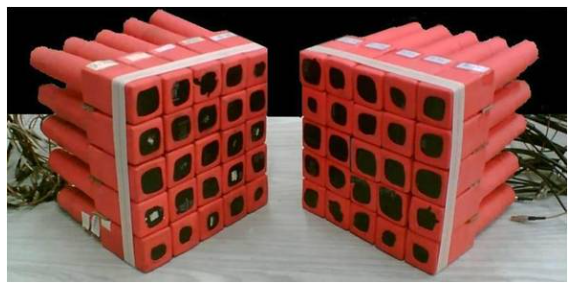
The 50 element BaF2 multiplicity filter, each having dimensions of 3.5 cm x 3.5 cm x 5 cm, is generally used in conjunction with the LAMBDA high energy gamma-spectrometer (or with any other detection systems) for estimating the angular momentum populated in each event. Its fast time response (450 ps) is useful for taking the start trigger (instead of the cyclotron RF) for an improved time-of-flight measurement.
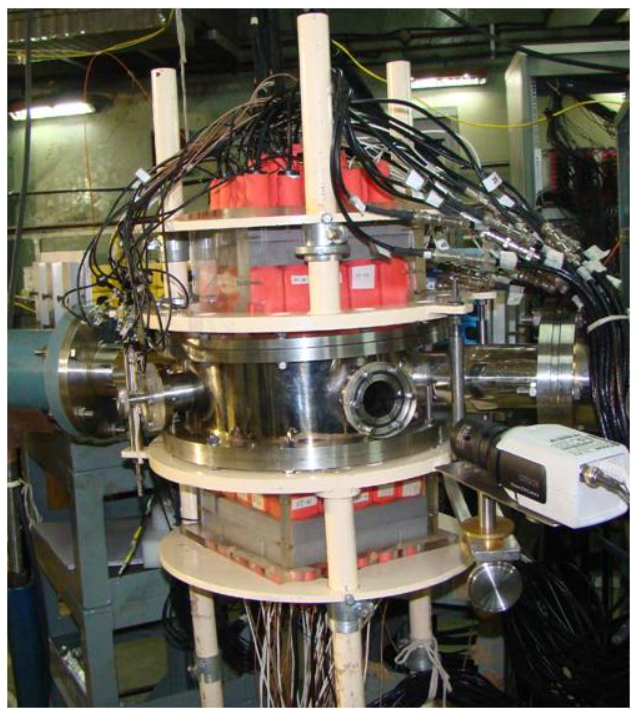
Penning Trap Developement
Penning trap is a device to store charged ions and sub-atomic particles. In a homogeneous magnetic field, a charged particle would undergo circular motion and be radially confined, but it would not be axially confined. It can be shown that a charged particle can be trapped both radially and axially by putting it in a strong homogeneous magnetic field and weak inhomogeneous (electrostatic potential being quadratic with the axial and radial distances from the center) electrostatic field. Under the action of such magnetic and electric fields, a charged particle undergoes a complicated motion comprising axial oscillation, cyclotron motion and magnetron motion. The frequencies of the axial and cyclotron motions depend on the mass of the charged particle. Since it is possible to measure frequencies very accurately, one can measure the mass of the trapped charged particle very accurately by undertaking precision measurements of its axial and cyclotron frequencies. Usually Penning traps are used for high precision mass measurements of the charged particles. However Penning traps are also used for many other purposes such as quantum computation, neutrino-electron angular correlation studies in beta decay etc.
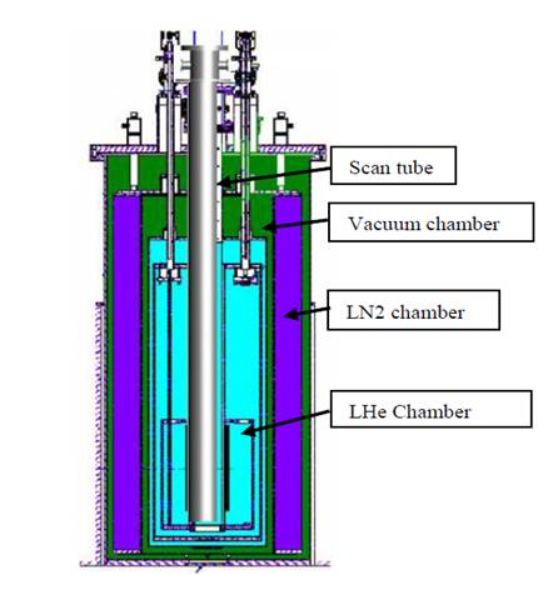
At VECC, we are building a cryogenic Penning trap facility where the trap would be at liquid helium (4 K) temperature and plan to put in radioactive ions in it. In addition to mass measurements, our emphasis would be to measure the kinetic energies of the recoiled nuclei from the beta decay and electron capture processes. In this way, we plan to measure Q-values of the beta decay processes with high precision using our Penning trap system. Such high precision Q-value measurements of beta decay processes are required for various tests of Standard model (such as the unitarity of CKM matrix elements). Very high precision measurements of the end-point of the recoil nuclei from the beta decay processes might also provide us a new method to directly measure the mass of an electron neutrino.
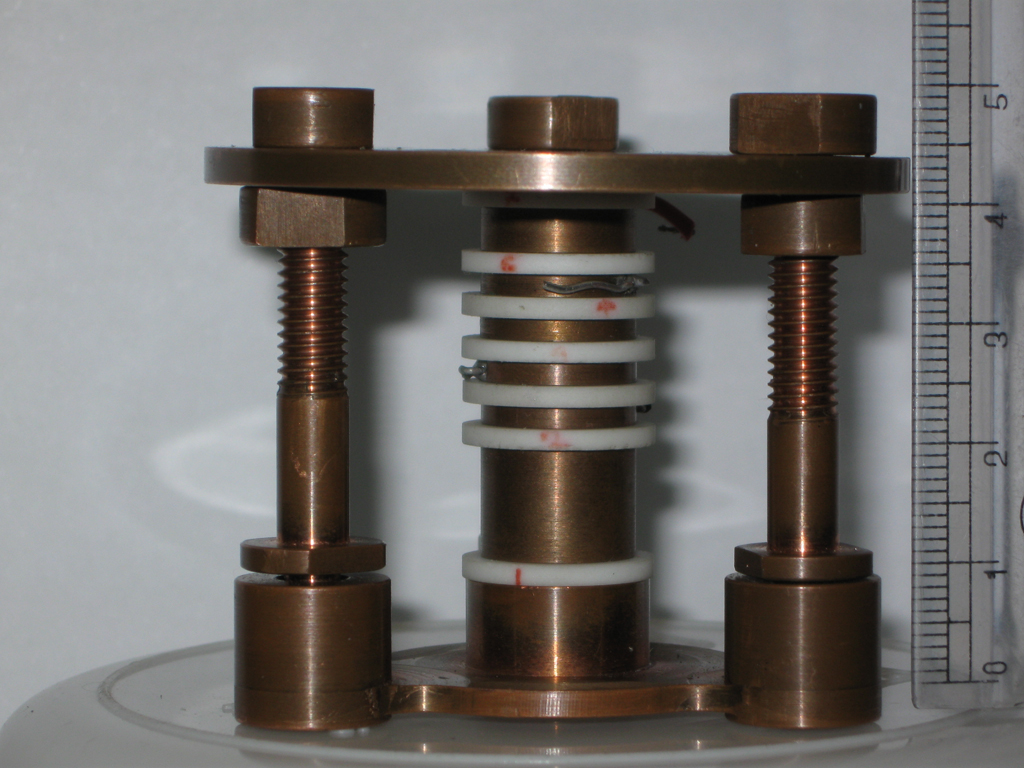
High-energy photon spectrometer
Electromagnetic radiation produced in nuclear reactions has been an important subject of study since the beginning of nuclear science. Since, the electromagnetic radiation is not seriously affected by the nuclear medium, it is the most suitable probe of choice to the study the properties of nuclear systems. In order to measure the high-energy gamma rays from hot nuclear systems, the following two detector systems (LAMBDA & GAMMA) have been developed in-house and are currently being used.
Charged Particle Detector Array (CPDA)
A 4pi-charged particle detector array is being developed at VECC. The array will consist of three parts: (a) the forward array covering 7 to 45 degree with silicon-silicon-CsI(Tl) telescopes, (b) extreme forward array covering 3 to 7 degree with phoswich detectors and (c) the backward array covering 45 to 175 degree with 330 CsI(Tl) crystals.
The forward array will consist of 24 Silicon-Silicon-CsI(Tl) telescopes, each composed of a 50 micron thick silicon strip (16 segments) detector (delE1), a 500 micron/1 mm ( delE2/ E) thick double sided (16 x 16 segments) silicon strip detector (DSSD), and four 6 cm thick CsI(Tl) detectors.(E). Thus, the E detector will provide two dimensional position information as well as good isotopic identification for the fragments with (Z < 10) produced in low and intermediate energy heavy-ion reactions. In addition to good isotopic resolution, it will also provide a low energy threshold for particle identification. The CsI(Tl) detectors will detect proton of maximum energy of E/A = 140 MeV and 16O ions of energy E/A = 335 MeV respectively. The angular coverage of the forward array would be ~ 7o -45o. The CsI(Tl) crystals are trapezoidal in shape, having 2.5 x 2.5 cm2 front face and 3.5 x 3.5 cm2 back face respectively and coupled to a photodiode due to the excellent linearity of the photodiode over a wide dynamic range and compact size.
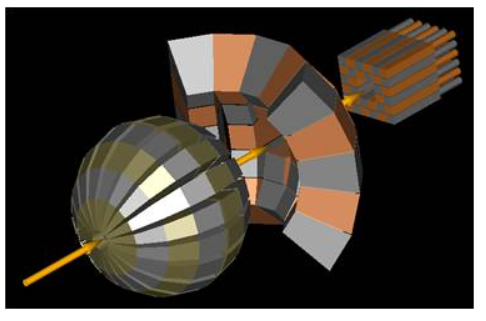
Design view of the CPDA
In-beam performance of a prototype telescope of the forward array has been tested with145 MeV 20Ne beam at VECC. All Strips and the CsI(Tl) detectors were read out individually using standard readout electronics and a VME-based online data acquisition system developed at VECC to collect data on event-by-event basis.
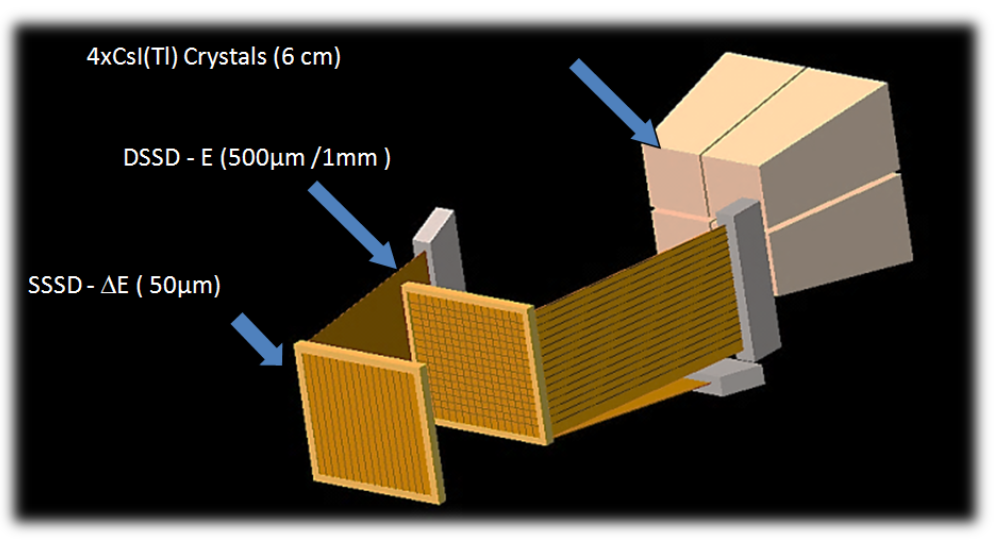
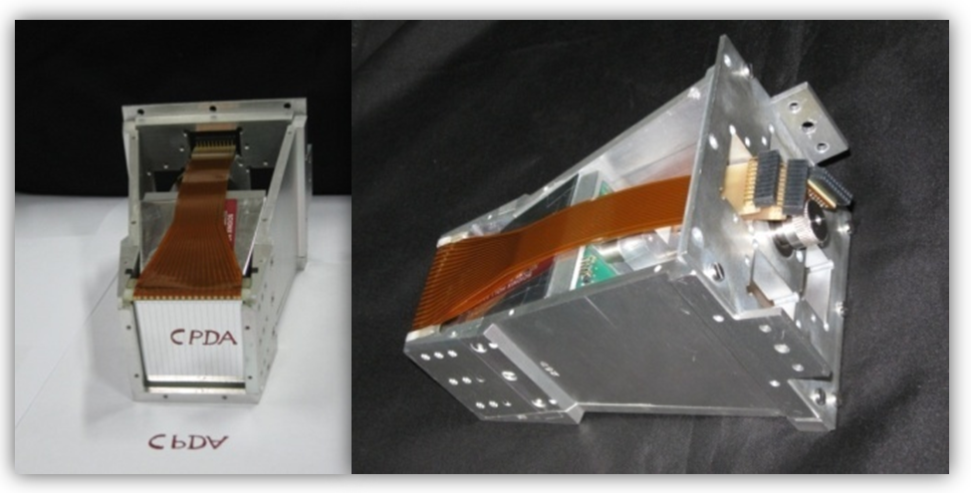
The extreme forward array which will cover the angular range of 3o -7o, will be made up of 32 phoswitch detectors (combinations of fast and slow plastic scintillators).
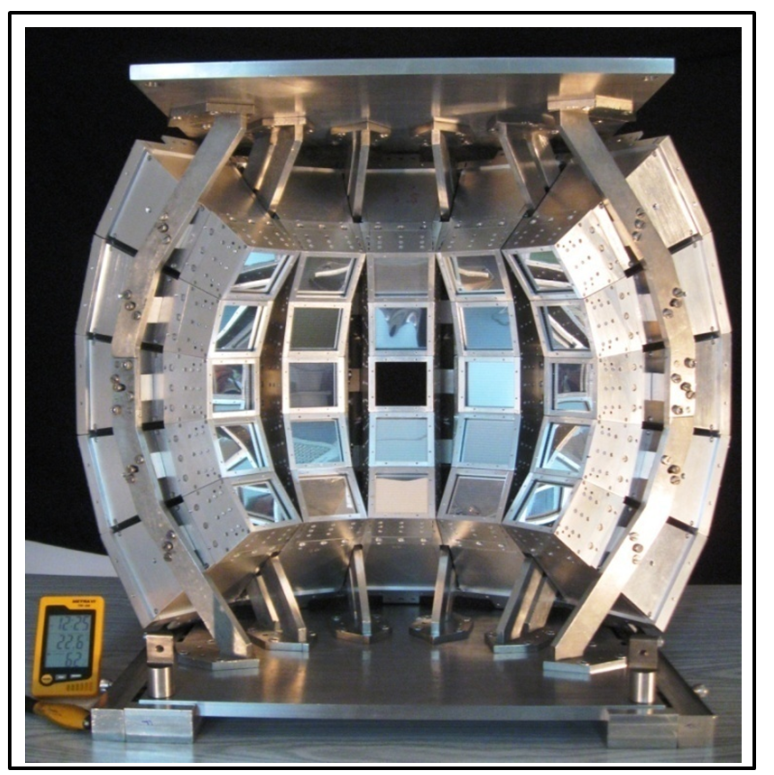
Photograph of the Charged Particle Detector Array (CPDA)
The decay time for the fast plastic scintillator is 2 ns while that for slow plastic is 280 ns. Prototype plastic phoswich detectors have been developed, which consist of fast and slow plastic of thickness 200 mm and 100 mm respectively. The phoswitch detectors were then optically coupled to a low power photomultiplier tube to collect the scintillation light. Typical energy thresholds in 200mm fast scintillators for different ionizing particles are ~4MeV for proton, ~4MeV/A for alpha and ~7MeV/A for 16O. In - beam performance of these detectors have been carried out using 145MeV 20Ne ion beam from the Variable Energy Cyclotron, Kolkata, on a mylar target and the particle separation obtained is shown below.
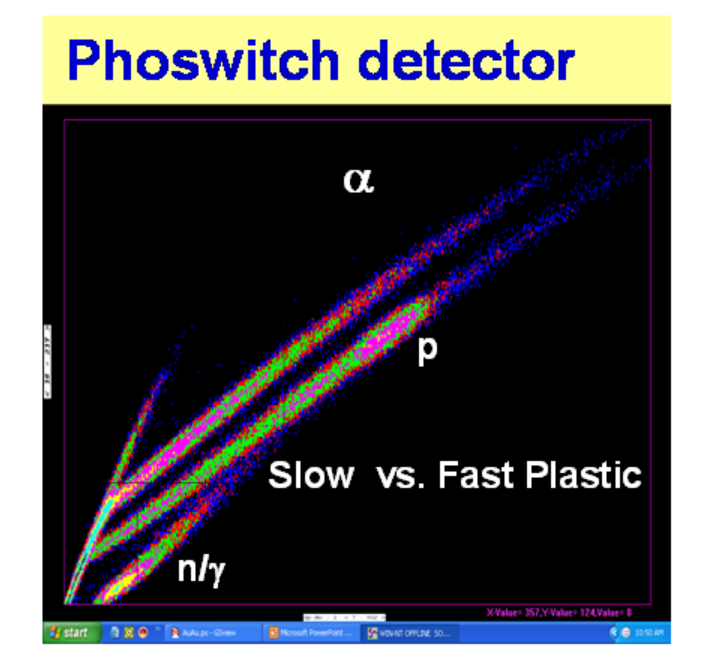
The backword part, covering the angular range 45 degree to 175 degree will consists of 300 CsI(Tl) crystals of different size and shape.
Material Science
Overview
Materials Science is an interdisciplinary field of science involving the properties of matter and its applications to various areas of science and engineering. This field of science tries to correlate and establish proper relationship between the structures of materials at the length scale from atomic dimension to the dimension of micrometer to their macroscopic properties. In the Material Science Section of Physics Group we try to understand this correlation with the help of theoretical, computational and experimental techniques. In this regard we are primarily involved in the following activities;
Defect Dynamics:
> Understanding of the basic mechanisms of the plastic instability in Portevin-Le Chatelier effect
> Study of the dynamics of dislocation by molecular dynamics simulation techniques
Radiation Damage Studies:
> Characterization of microstructure of deformed and irradiated nuclear structural materials by X-Ray diffraction
> Developing irradiation facilities in the Materials Science beamline of the DAE Medical Cyclotron
Development, characterization and physical studies of nanostructured multifunctional materials
> Multiferroic perovskites with ferroelectricity, ferromagnetism and ferroelasticity
> Graphene and conducting polymer based super-capacitors with application in energy cells
Collaborations
Research
Synthesis of single phase nano BiFeO3 particles and its irradiation studies
BiFeO3 (BFO) is a multiferroic material exhibiting both ferroelectric and antiferromagnetic ordering that has rendered it to a new dimension of multifunctionality. The remarkable property of multiferroic materials stems from the magnetoelectric effect i.e. the coupling between magnetic and electric ordering. Sol-gel technique has been adapted to get the nano BFO particles of ~30nm. BFO nanoparticles have been subjected to irradiation with 35MeV a-particles available at Variable Energy Cyclotron. Irradiation induced defects have been characterized by PAS. Magnetic & electrical polarization studies are going on.
Understanding of the basic mechanisms of the plastic instability in Portevin-Le Chatelier effect
Many materials when subjected to deformation exhibits unstable plastic flow beyond the elastic limit. In certain range of strain rates and temperatures many solid solutions, both substitutional and interstitial, exhibit serrated yielding which is also referred as the Portevin-Le Chatelier (PLC) effect in literature. The origin of the PLC effect stems from the interaction of dislocations with solute atoms. Dislocation is the line defect within the crystal structure, along which some atoms are misaligned. In metallic alloys, the added solute atoms have their own strain fields. These strain fields interact with the strain field of the dislocations through various mechanisms and under certain experimental conditions the collective movement of the dislocations translates into PLC instabilities. The PLC effect is characterized by inhomogeneous deformation and results in serrated stress-strain characteristics as shown in Fig.1. The strains are localized as deformation bands and with increasing strain rate and/or decreasing temperature, the band character changes from static type C to hopping type B and finally to continuously propagating type A.


The intriguing spatio-temporal dynamics of the PLC effect has fascinated the researchers over several past decades. Moreover, it has some detrimental effects on the mechanical properties of the material. Hence, a huge amount of works are being done to understand the underlying dynamics of this phenomenon. In our section, several techniques of nonlinear dynamics and time series analyses have been adopted to study the dynamics of the PLC effect in different band regime indirectly from the stress-time series data. The tensile tests are performed on substitutional Al-2.5%Mg alloy and interstitial low carbon steel using the Universal tensile Testing Machine INSTRON over a wide range of strain rate. Analyses of the stress-time data reveals that the PLC dynamics in type A band regime has the memory less Markov property and the effective dimension of the dynamics is found to decrease with strain as shown in Fig.2. In the type B band regime, PLC dynamics exhibits deterministic chaos. The differences in relative positions of the solutes in substitutional and interstitial alloys are reflected in difference in the degrees of freedom of the dynamics. Moreover, a transition regime from type A to type B band could be identified and further analyses revealed that both type A and type B band does not exist simultaneously, instead a single band changes its character during deformation. Even though the band characters are different in different experimental conditions, the stress data recorded during the PLC effect is a macroscopic output of the dynamics. Thus the data should possess some general characteristics independent of the strain rate. This motivated to search for a common feature in the PLC dynamics with imposed strain rate and two different techniques of time series analysis were adopted for this purpose: (1) Scaling analysis and (2) Quantification of complexity. The result of scaling analyses clearly suggests that the scaling behavior of the overall dynamics of the PLC effect at all strain rates follow Levy-walk property. Fig.3 exhibits the scaling nature of the Standard deviation Analysis (SDA) and Diffusion entropy Analysis (DEA) of the stress vs. time data obtained from Al-2.5%Mg alloy during tensile deformation at a strain rate of 3.85x10-4 Sec-1.

The complexity of the PLC dynamics is estimated through Multi Scale Entropy (MSE) analysis and it is observed that MSE analyses can be successfully employed to identify the type A and type B band regime. The transition regime could also be identified with this technique.
Study of the dynamics of dislocation by molecular dynamics simulation techniques
Molecular dynamics (MD) simulation has recently become a popular technique to study dislocation dynamics, which ultimately aims to predict the mechanical properties of crystalline materials. In VECC, simulation based works in dislocation dynamics have been initiated and the interesting results show a considerable promise for further contributory research in this important subject area. The primary areas of our interest are behavior of lattice resistance in nano-dimension, interaction between dislocation and defects, understanding the mechanism of dislocation climb at nanovoids etc. using MD simulation technique.
A. Lattice resistance at the nanoscale: Mechanical and carrier transport properties of thin films are extensively dependent on the structure, distribution and dynamics of dislocations present in them. Particularly in nanomaterials, the surface should play a vital role in dictating this dynamics as the dislocations are too close to the surfaces. A dislocation can move under the influence of a shear load, thereby causing the plastic strain in the crystal. Dynamics of dislocations are governed by drag forces including lattice resistance and other drags, although the effect of surfaces on mobility of dislocations has not been in focus of study so far.
We propose a model [PRL 101, 115506 (2008)] that reveals a prominent change in the velocity of a dislocation due to the presence of a free surface in the proximity of the dislocation line in a finite nanoscale crystalline solid. This effect has been attributed to the altered lattice resistance to dislocation motion in different system configurations. To verify this finding, MD simulations for an edge dislocation in bcc Molybdenum (Mo) are performed and the results (Fig. 1) are found to be in agreement with the numerical implementations of this model. The reduction in this effect at higher stresses and temperatures, as revealed by the simulations, confirms the role of lattice resistance behind the observed change in the dislocation velocity. We think that such an alteration in the velocity of dislocation would play a significant role in deciding the mechanical properties in thin films.
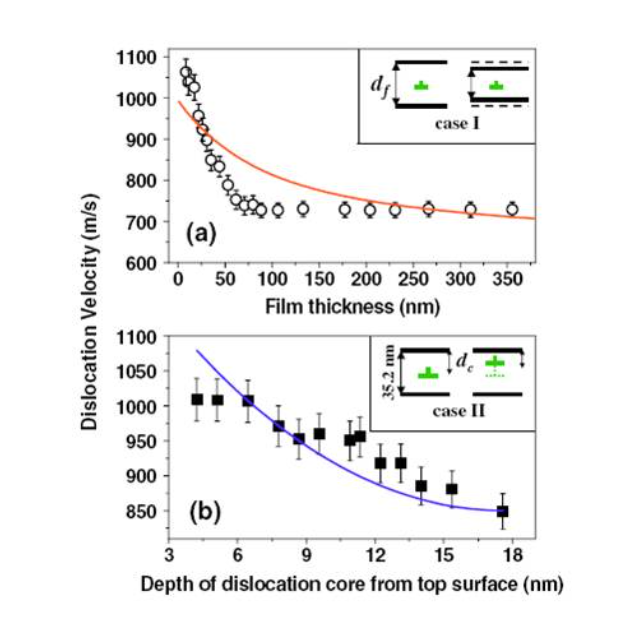
B. Study of dynamics of dislocation pinning: The phenomenon of dislocation pinning is vital to the process of plastic deformation and dictates the mechanical strength of a crystalline solid. A moving dislocation can get pinned upon its interaction with obstacles like point defects, voids, precipitates and other dislocations. In this context, a substantial amount of research in dislocation science explicitly deals with the process of depinning and its relation with the nature of the obstacles. Owing to its effective mass, a moving dislocation is associated with certain momentum and kinetic energy, which is known to dissipateafter it gets pinned. However, the dynamics of pinning at ultrafine scales of length and time are still unexplored.
We harness the techniques of MD simulations to reveal the dynamics of dislocation pinning and report for the first time, observations of damped oscillations [Phys. Rev. B 82, 184113 (2010)] of pinned dislocation segments under static shear load (refer Figure 2). Studies are performed in two different systems, namely Molybdenum (Mo) and Tungsten (W). We have also used Koehler’s vibrating string model as a mathematical tool to analyze the simulation output. The combined approach of MD simulation and analytical solution reveal significant features of dislocation dynamics. Our MD results reveal that the relation between the oscillation frequency and the link length significantly differs from that predicted using the framework of the celebrated Koehler-Granato-Lücke theory, which leads us to modify the model assuming coupled oscillations of dislocation segments in contrast to the conventional idea of independent oscillations. We would like to point out that the reported oscillations may solve the longstanding mystery of electromagnetic emission occurring during the plastic deformation and earthquakes.
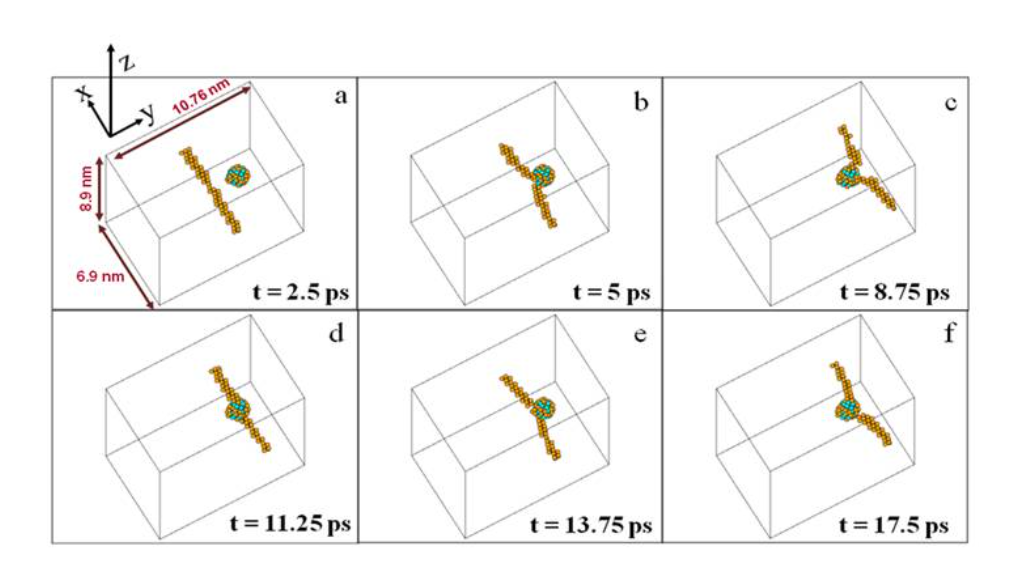
C. Study on void induced dislocation climb (VIC) : The phenomenon of dislocation climb is important in context of irradiation creep and existing theories of climb are formulated in the framework of diffusion based kinetics. With advent of simulation techniques, a new kind of climb by the gliding dislocations at nanovoids has been recently observed in both molecular statics (MS) and molecular dynamics (MD) simulations and this process seems to be much faster. This is known as void induced climb (VIC) and we attempt to explore the underlying mechanism of this void-induced climb (refer Figure 3) in bcc systems.
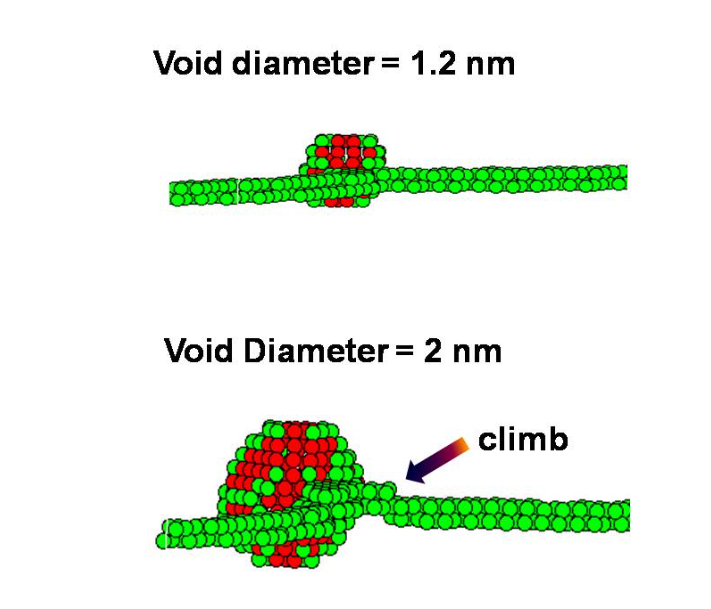
In this work, we present a novel simulation strategy, which estimates the energies associated with the void-induced climb of dislocations. The results highlight that the curvature of the pinned dislocation segment plays a key role in mediating this climb. The lowering of critical depinning load and the effect of thermal assistance to void-induced climb is also explained. Our study reveals that the kinetics of this climb process is fundamentally distinct from the conventional diffusion-controlled climb. [Acta Materialia 60, 3789 (2012)]
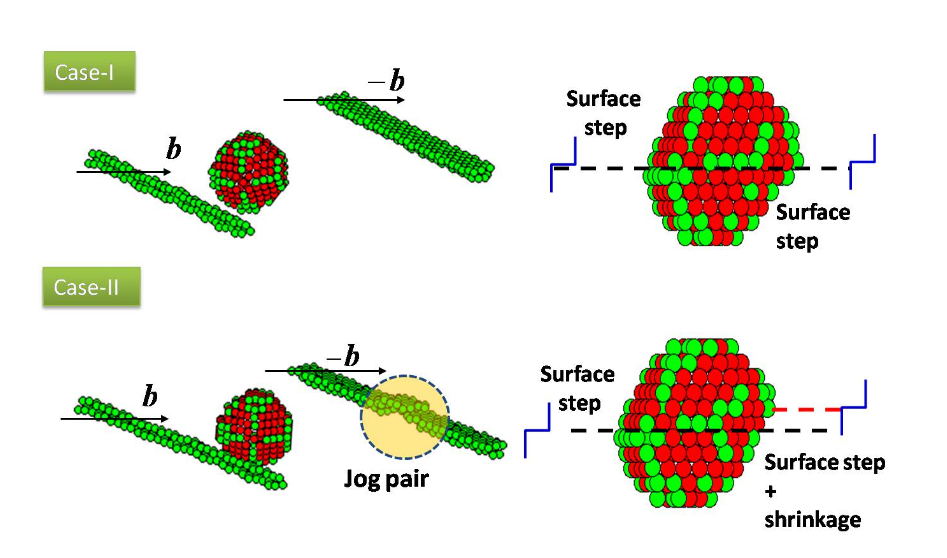
Contact person : Dr. Mishreyee Bhattacharya
mishreyee[at]vecc.gov.in
Developing irradiation facilities in the Materials Science beamline of the DAE Medical Cyclotron
A medical cyclotron facility, is coming up in Kolkata by the Department of Atomic Energy, where we are involved in developing irradiation facilities to carry out accelerator based radiation damage studies on nuclear structural materials.
The high intensity proton beams from the DAE Medical Cyclotron (Energy : 15 MeV to 30 MeV and Current: upto 350 micro-amp) provides a unique facility for radiation damage studies on nuclear materials, as energetic charged particles are useful for simulating the bulk damage induced by fast neutrons. For example 20 MeV protons with 350 microampere current will produce in stainless steel a damage of 2x10-5dpa/sec over a sample thickness of about 0.7mm. This is higher than the damage rate produced in fast reactors (~10-6dpa/sec). Due to the high energy available from this Medical cyclotron, thick samples of the order of 0.5 to 1 mm can be irradiated. This makes the post irradiation investigation of the samples by a variety of bulk techniques like X-ray, Positron lifetime, mechanical property measurements feasible. The main interest will be in studying the irradiation effects in Fast Breeder Reactor structural materials like D9, D9I and ferritic steels. Some of the important studies that will be carried out are (1) Ductile to Brittle Transition in Ferritic Steels, (2) Development of Void swelling resistant steels, (3) Phase Stability under irradiation in advanced austenitic steels etc. Apart from the above utilization for reactor materials, studying basic damage mechanisms will also be of importance for the better understanding of radiation effects in materials.
Another major area of research that will be carried out in the materials science beam line is the induced radioactivity studies using the proton beam available at the DAE Medical Cyclotron. (1) Thin Layer Activation Analysis of nano coatings, (2) Production of Special Isotopes for use as sources in various experiments like PAS, PACS etc., (3) Study of Mass, Charge and Angular Momentum distribution of fission products in proton induced fission of actinides etc. are some of the experiments that are proposed to be carried out.
The various experiments to be carried out will require different energies and currents. Taking into consideration the radiological safety, the Materials Science activities will be carried out in two different chambers depending on the energies and currents to be utilized for irradiation (as shown in the diagram). The chamber CH1 will be mainly used for high dose experiments where the currents will be of the order of 200 micro-amp. The low dose experiments up to about 50micro-amp beam current will be carried out at CH2. The development of the irradiation facilities include
1. Design of general purpose target chamber for irradiation
2. Development of target cooling facilities using Helium and water
3. Development of target handling facilities for handling high dose samples (including shielding wall arrangement and master-slave manipulator, Pb-cask for sample storage)
4. Safety and control of irradiation experiments
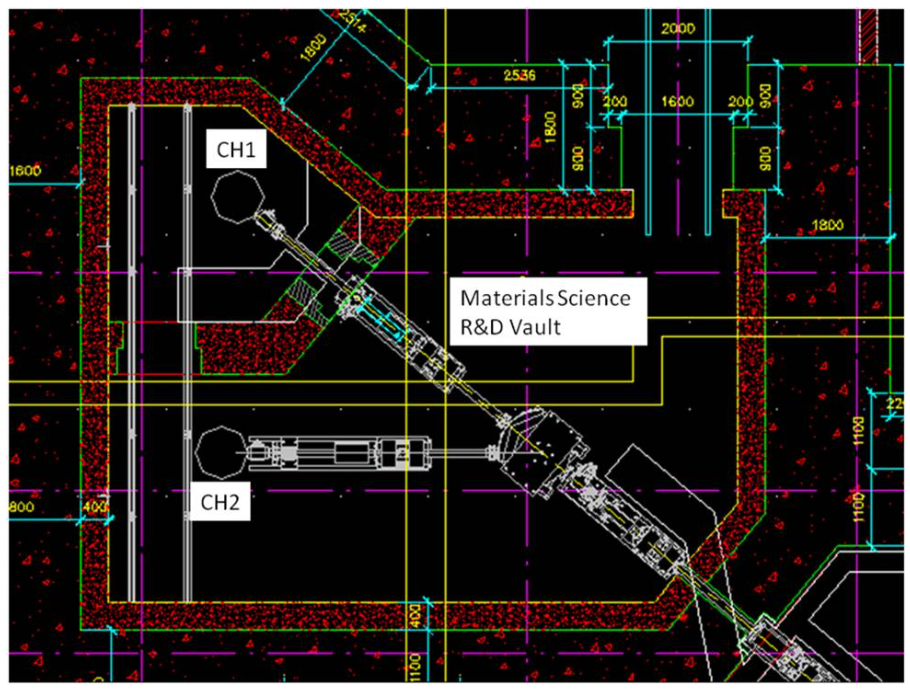
Characterization of microstructure of deformed and irradiated nuclear structural materials by X-ray Diffraction technique
Microstructural characterization by X-ray diffraction technique are being carried out on nuclear structural materials such as Zirconium based alloys (Zircaloy-2, Zr-2.5%Nb and Zirlo), SS316L and D9 (Ti-modified austenitic stainless steel) in which defects have been introduced by either cold deformation (by hand-filing and cold-rolling) or by irradiation with charged particles (light ions and heavy ions from Variable Energy Cyclotron and ECR source).
Nanotube Poly(3,4-ethylenedioxythiophene)
Nanotubular structure of poly(3,4-ethylenedioxythiophene)–NiFe2O4 nanocomposites have been synthesized in reverse microemulsion polymerization technique with the nanotube size ~20nm as characterized by Transmission Electron Microscope. The surface capacitance of this nanotubular material has been quite high.
Magnetic Behavior of Template Grown 2-D Array of Cobalt Nanowire:
The arrays of cobalt nanowires with diameter 50, 150 and 275 nm were prepared by dc electrodeposition technique. Magnetization study showed the change in magnetic easy axis from axial to perpendicular direction as one increased the length of 50 and 150 nm wire.
Synthesis and Magnetic Properties of Template Grown Nickel Nanowires:
Nickel nanowires in the pores of the alumina membranes have been developed by electro-deposition technique. The magnetic properties of the nanowires are changing sensitively with the length and the diameter of the nanowires. Competition between the shape anisotropy, magneto-crystalline anisotropy and strong magneto-static interaction between the nanowires has been observed.
Studies on Co-doped ZnO Nanoparticles:
Semiconducting oxides like ZnO display magnetism when doped (or, diluted) with magnetic transition elements. There is a phenomenon of polarization of charge carriers in the semiconductor by the spin of the magnetic elements doped. They are the candidates of the new generation Spintronics, i.e. spin coupled with electronics. ZnO doped with various atomic percentages of the transition metal Co (1-20 at.%) has been synthesized by wet chemical technique employing Zinc & Cobalt acetates. Particle sizes were in the range 60-100nm.
Ion Irradiation on ZnO thin films:
Magnetism can be induced in nontransitional metal oxides through the generation of defects introduced by ion irradiation. we undertook the studies on Argon ion irradiation on nontransitional semiconducting ZnO thin films.grown by RF sputtering at VECC. Thickness of the films were in the range 80-90nm.150 keV Ar (9+) ions were used with a range of 90nm. An onset of magnetism has been observed for the film irradiated at the fluence of 1x1016ions/cm2 evident from magnetization versus temperature plot.
Structural and electrical studies of low energy Ar9+ irradiated conducting polymer PANI-PVA using ECR Ion source:
Polyaniline (PANI) of high stability prepared in acidic aqueous solution using water soluble support polymer polyvinyl alcohol (PVA) was subjected to irradiation with 150keV Argon (Ar9+) ion. The dielectric constants are more for the Ar-implanted polymer than the unirradiated one. The dielectric loss is more for the implanted PANI rendering it useful for electromagnetic shielding.
Structural and impedance spectroscopy of perovskite barium substituted lead zinc niobate
Relaxor ferroelectric materials with a broad transition in dielectric constant have enormous applications in the field of actuators, transformers etc. Lead Zinc Niobate [Pb(Zn1/3Nb2/3)O3] (PZN) is a well known relaxor. But it is Pb-based and is likely to be toxic. To remove Pb, the complex perovskite lead barium zinc niobate, (Pb1-xBax)(Zn1/3Nb2/3)O3 ceramic at x = 0.25 [(Pb0.75Ba0.25)(Zn1/3Nb2/3)O3] was prepared by a columbite precursor method.
Nuclear Electronics
Overview
The section is involved in the development of nuclear instrument modules for various projects of VECC. Some of the modules that were developed are Current Integrator, Charge Sensitive Amplifier, and a Dual Gate and Delay Generator and a Quad Fast Discriminator. The section also helps various users in the maintenance for many nuclear instrument modules. The section is in close association with Experimental High Energy Physics and Application (EHEPA) group and is involved in building electronics for high energy physics experiments being carried out by the EHEPA Group. The responsibilities include design, development and fabrication of readout boards for Photon Multiplicity detectors based on gas proportional chambers which were installed both at Brookhaven National Laboratory-USA and CERN – Geneva. At present the group is building readout PCBs and Front End Boards of GEM detectors for Muon chambers in CBM experiment which will be installed in future at GSI Darmstadt, Germany and developing front-end electronics for high resolution silicon detectors for the forward calorimeter in the ALICE Experiment. The jobs involve extensive testing of ASICS like GASSIPLEX, MANAS in huge numbers individually before they are mounted on the readout boards. The assembled boards are tested individually first, in chains later and then finally on the detector applying high voltages.A cosmic ray setup has been made to test the prototype GEM detectors to study MIP response, variation of gain with HV and to determine the efficiency of the prototype detectors.
Collaborations
This section works in close association with Experimental High Energy Physics and Applications Group of VECC along with various other Universities in India and is involved in HEP experiments being carried out at BNL-USA, ALICE-CERN at Geneva, CBM experiment GSI Darmstadt. The list of universities includes
Jammu University, Jammu
Rajasthan University, Jaipur
Punjab University, Chandigarh
Research
Electronics for STAR PMD at BNL-USA
Readout for PHOTON MULTIPLICITY DETECTOR (PMD) in STAR involves reading 82K channels from anode wires of gas proportional chambers. The processing of PMD signals is carried out by a Gas-4 board comprising 4 Gassiplex chips. The detector signals are coupled to this GAS-4 board in a group of 64 by a 70 pin SAMTEC connector. Each of the 4 Gassiplex consistsof 16 channels each with a CSA, de convolution filter, Shaper, TRACK/HOLD, buffer and an analog multiplexer and buffer and reads 64 channels. Two types of GAS-4 boards have been designed for use with detector modules which are rhombus shaped in geometry. The GAS-4 boards have been designed to plug protection boards with diodes. These boards protect the Gassiplex against possible sparks in the detector.
All the FEE boards are mounted on the detector. The entire readout is organized on 48 chains with each chain reading 1728 channels. Each chain consists of one Translator board, 27 Gas-4 Board and one buffer board to carry the analog multiplexed output signal to the DAQ system. A Translator board translates all NIM signals LVTTL levels required by Gassiplex. The control signals i.e. CLOCK, CLEAR, TRACK/HOLD signals are connected through the Lemo connectors on the board. The polarity of the signal output from the buffer board can be made positive or negative depending input polarity chosen on C-RAMS. The low voltage segmentation on the module is done using a low voltage distribution board.The DAQ system consists of CRAMS and Sequencer. Each C-RAM can handle 2K channels and can accept 2 inputs. The Inputs can be of either polarity. A maximum of 19 CRAMS can be controlled by one Sequencer which generates all control signals like Clock, Clear and Track/HOLD signals.
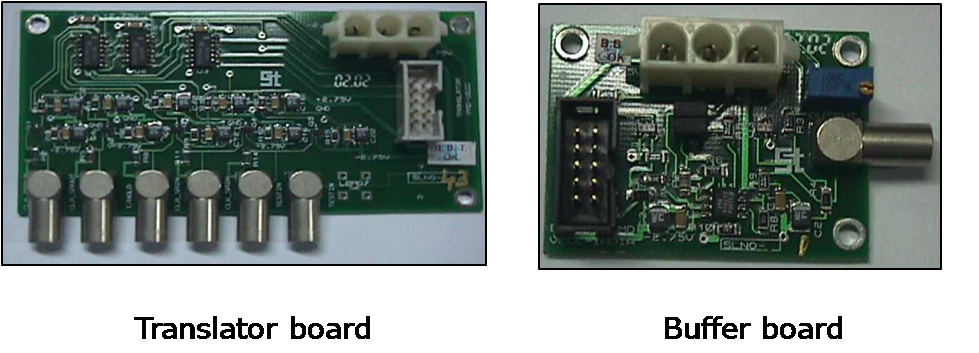
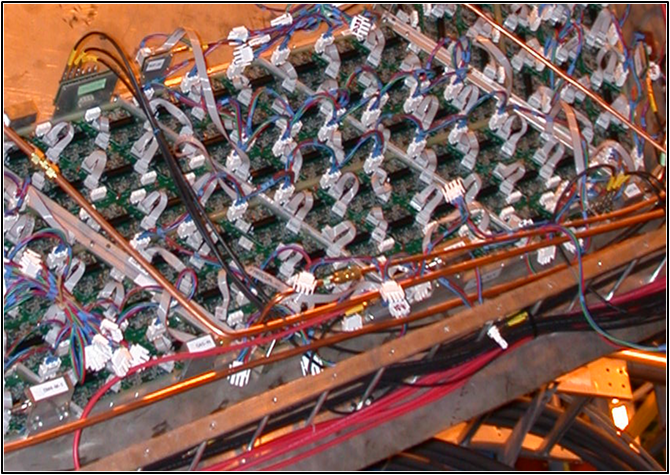
Electronics for ALICE PMD at CERN, GENEVA
Readout for PHOTON MULTIPLICITY DETECTOR (PMD) in ALICE involves reading 200K signals from anode wires of gas proportional chambers. The detector signals are coupled to the FEE board (6 Layer PCB)through flexible kapton PCB in a group of 32.The processing of PMD signals is carried out by a FEE BOARD comprising 4 MANAS CHIPS,2 buffer amplifiers, 2 serial 12 bit ADCs (AD7476) & custom built ASIC called MARC( Muon Arm Readout Chip). Each of the 16 channels MANAS consists of CSA, deconvolution filter, Shaper, TRACK/HOLD, buffer and an analog multiplexer. MARC controls 4 MANAS CHIPS, 2 ADCS and performs Zero suppression on data and communicates with DSPs through 4 bit bus. 32 bit word is sent by Link port bus in 8 nibbles of 4 bits each. DATA ACQUISITION is done by a cluster of DSPs called CROCUS (Cluster Readout & Concentrator Unit Systems).
A Translator board translates all LVTTL signals to LVDS and vice versa. This interfaces DAQ with FEE boards. All the FEE boards and Translators are mounted on a backplane PCB carrying all LVTTL signals and low voltage segmentation. The entire readout is organized on 48 modules with each module comprising 4608 channels. Each module is divided in to 6 chains each reading 768 channels. The low voltage segmentation for the module is done using a low voltage distribution board.

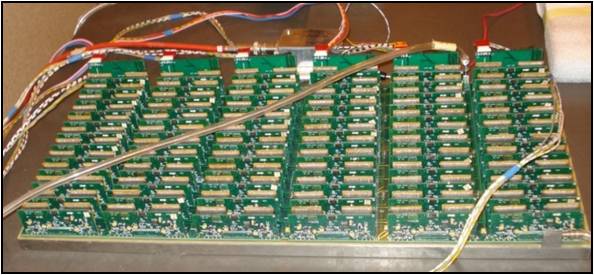
Electronics for CBM experiment at GSI Darmstadt
VECC will develop a large part of the Muon detection at the CBM experiment in upcoming FAIR facility. The jobs involved are R&D and fabrication of fast and high resolution gaseous detectors using GEM and associated fast and high density electronics. The readout to be used for CBM is based on self-triggered concept with associated time stamp. Future activity of the section will include design and building of chamber printed circuit boards and associated electronic boards.A 2 Chip Front End Board reads 256 signals from GEM detectors. The top and bottom Copper of 8 layers PCB with 2 NXYTER chips is shown below. Each NXYTER reads 128 signals. The GEM detectors can also be tested with FEE boards comprising MANAS and designed for ALICE PMD.
Electronics for CBM experiment at GSI Darmstadt
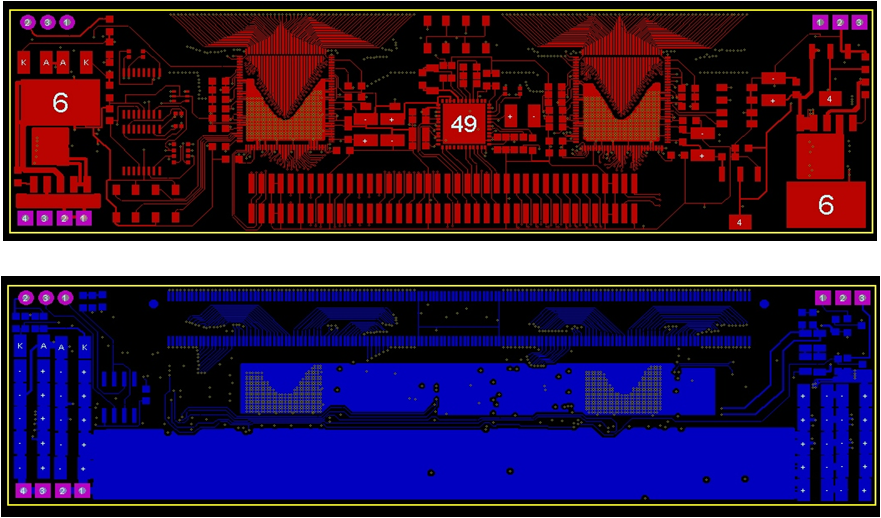
For testing of the prototype GEM detectors we have developed PCBS with different pad sizes like 3,4 sq mm comprising 256,512 pads and were being used. One such PCB is shown below with 256 pads and is read by 2 no of a front end board (FEB) with one N-XYTER with each FEB reading 128 channels.The one chip FEBS with one n-XYTER were developed at GSI.
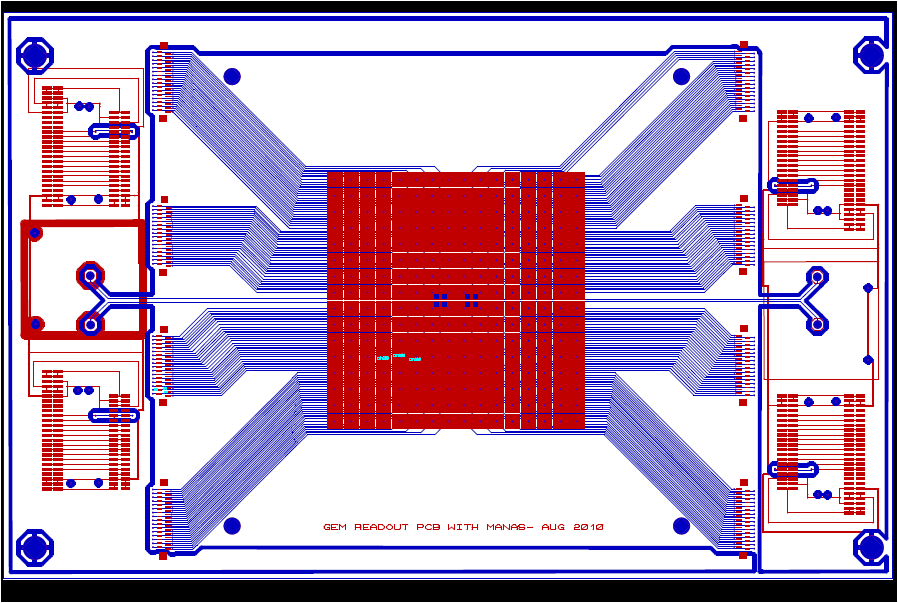
Nuclear Instrument Modules for low energy experiments for VECC
A current Integrator has been developed that is used in Control room of VECC to measure beam currents in the range of 1nA to 1mA. A Charge Sensitive Amplifier (CSA) and dual gate and delay generators have been designed for the use of experimentalists in our centre.

Nuclear Instrument Modules for low energy experiments for VECC
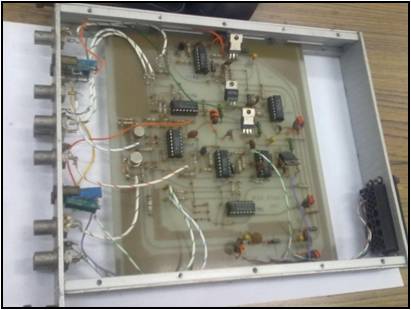
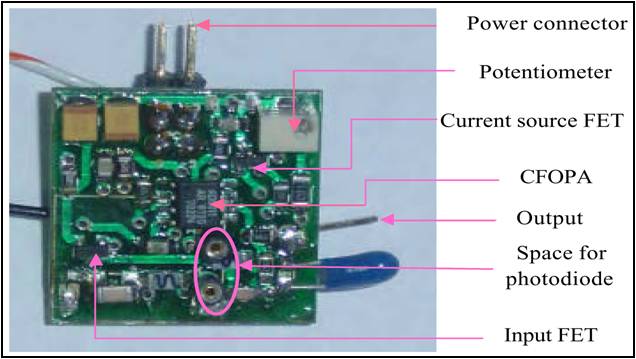
Forward Calorimeter in ALICE
For the proposed Forward calorimeter (FoCAL) in ALICE,a new detector system using silicon PAD detectors is being worked out. We plan to procure with the help of Electronics Division BARC, which will develop (6 x 6) 1 cm2 silicon Pad detector at CMEMS Centre and fabricated by BEL (Bharat Electronics Limited). Total 50 detector arrays will be fabricated for the first prototype. We plan to use both INDIPLEX and GASSIPLEX for the readout purpose. The FEE boards designed for use in ALICE PMD comprising MANAS can be modified for use with Gassiplex chips and operating in silicon mode to take advantage of higher dynamic range in this mode. Necessary modifications are being done on the readout boards for this purpose. Also we plan to design a new fee board with INDIPLEX which is developed by Electronics Division BARC.
Forward Calorimeter in ALICE
We have already procured 2 nos of 32 channel silicon strip detectors from BEL, Bangalore to study their characteristics and explore the possibility of using them at VECC. After measuring leakage current of these detectors some preliminary tests were done with different alpha sources in vacuum. Typical specifications for the strips are:
Detector size: 63 mm x 63 mm.
Strip size: 60 mm x 1.78 mm.
Strip pitch: 1.9 mm.
Wafer thickness: 320+/-15 microns.
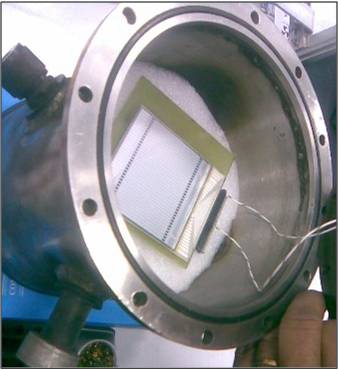
32 channel silicon strip detector (developed by BEL, Bangalore).
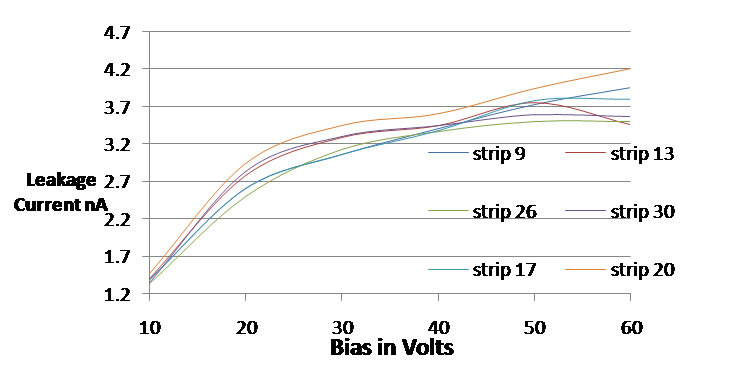
| S.No | Title | Date | Speaker |
| 1 | Dynamics of fusion fission reactions near Coulomb barrier | Abhirup Chaudhuri | |
| 2 | Evolution of perturbation in a hydrodynamically expanding system formed in relativistic heavy ion collision | Golam Sarwar | |
| 3 | Non-extensive Drag and diffusion Coefficients of the heavy quarks travelling through non-Abelian Plasma | Dr Trambak Bhattacharyya,Bogoliubov Laboratory of Theoretical Physics, JINR, Dubna, Russa. | |
| 4 | Study of direct photon production from relativistic heavy ion collisions | Pingal Dasgupta | |
| 5 | Equations of states for white dwarfs and neutron stars | Somnath Mukhopadhyay | |
| 6 | Nuclear Structure Studies in Mass Region A~60-70 | Dr Siddarth Rai | |
| 7 | Micro-Pattern Gaseous Detectors – Device Physics and Potential Applications | Purba Bhattacharya | |
| 8 | Search for the Vortical and the Chiral Magnetic Effects at the Relativistic Heavy Ion Collider | Prithwish Tribedy | |
| 9 | Surface and interface modification by low energy ion beams | Dipak Bhowmik | |
| 10 | Transport Coefficients of Hot Hadronic Matter | Utsab Gangopadhyaya | |
| 11 | Measurement of azimuthal correlations between D-mesons and charged particles in pp collisions at {sqrt}s = 13TeV with ALICE at the LHC | Samrangy Sadhu | |
| 12 | Nuclear structure far from stability: science and techniques | Prof. Partha Chowdhuri of University Of Massachusetts Lowell, USA | |
| 13 | Spectral properties of hadrons in a magnetized medium | Snigdha Ghosh | |
| 14 | Possibility to develop a detection system for elusive particles at FRENA | Tilak Kumar Ghosh | |
| 15 | 'Heavy' breaking of boost invariance by heavy quarks in relativistic heavy ion collisions | Sandeep Chatterjee, AGH University of Science and Technology, Poland | |
| 16 | Study of Nuclear Structure around N=90 | Arunabha Saha | |
| 17 | Study of nuclear viscosity and isospin mixing utilizing isovector giant dipole resonance | Debasish Mondal | |
| 18 | Understanding The Thermodynamics of Strongly Interacting Systems in Effective QCD Models | Soumitra Maity, Bose Institute |
| Article | Author | Journal/Symposium | Year |
| Statistical approach of nuclear multifragmentation with realistic nuclear equation of state | S. Mallik | Phys. Rev. C 107, 054605 | 2023 |
| Frequency mixing property of electron cloud in a Penning trap at room temperature | Joydip Nandi, A.K. Sikdar, Parnika Das, A. Ray | Nucl. Instru. and Meth. A, 1056,168647 | 2023 |
| Pairing phase transition in an odd–even hot 69Zn nucleus | Enakshi Senapati, Satabdi Mondal, Srijit Bhattacharya, Deepak Pandit, N Dinh Dang, Nguyen Ngoc Anh, L T Quynh Huong, Rajkumar Santra, N Quang Hung, and Balaram Dey | J. Phys. G: Nucl. Part. Phys. 50 (2023) 075104 (10pp) | 2023 |
| Enhanced symmetry energy may bear universality of r-process abundances | José Nicolás Orce, Balaram Dey, Cebo Ngwetsheni, Srijit Bhattacharya, Deepak Pandit, Brenden Lesch, Andile Zulu | Monthly Notices of the Royal Astronomical Society, Volume 525, Issue 4, 6249 (2023). | 2023 |
| Exploring quasifission dynamics in reactions leading to the formation of 225Pa | K. Atreya , A. Sen, T. K. Ghosh , A. K. Nasirov , D. Paul, Md. Moin Shaikh, K. Banerjee, C. Bhattacharya,Samir Kundu, S. Manna, G. Mukherjee , S. Nandi, R. Pandey, T. K. Rana,Pratap Roy, S. Mukhopadhyay etal | Phys. Rev. C 108, 034615 (2023) | 2023 |
| Lifetimes and transition probabilities for low-lying yrast levels in 130,132Te | D. Kumar, T. Bhattacharjee, S. S. Alam, S. Basak, L. Gerhard, L. Knafla, A. Esmaylzadeh, M. Ley, F. Dunkel, K. Schomaker, J. -M. Régis, J. Jolie, Y. H. Kim, U. Köster, G. S. Simpson, and L. M. Fraile | Phys. Rev. C 106, 034306 | 2022 |
| S-shaped heat capacity in an odd–odd deformed nucleus | Balaram Dey, N. Quang Hung, Deepak Pandit, Srijit Bhattacharya, N. Dinh Dang, L. T. Quynh Huong, Debasish Mondal, S. Mukhopadhyay, Surajit Pal, A. De, S. R. Banerjee | Phys. Lett. B 789, 634 | 2022 |
| Quasifission in 84, 86Kr-induced reactions populating superheavy elements | A. Sen, T. K. Ghosh, E. M. Kozulin, I. M. Itkis, G. N. Knyazheva, K. V. Novikov, S. Bhattacharya, K. Banerjee, and C. Bhattacharya | Phys. Rev. C 105, 014627 | 2022 |
| Viscosity to entropy density ratio ($\eta$/s) in nanoliquid | Md Moinul Islam, Alokkumar De, Deepak Pandit, Balaram Dey, Nazmus Sakib & Srijit Bhattacharya | Physics and Chemistry of Liquids 00319104 | 2022 |
| Design of a helical resonator with improved figure of merit | J . Nandi, A. K. Sikdar, P. Das, and A. Ray | Review of Scientific Instruments 93, 014706. | 2022 |
| Signature of fusion suppression in complex fragment emission | S. Manna, C. Bhattacharya, T. K. Rana, S. Kundu, R. Pandey, A. Sen, T. K. Ghosh, Pratap Roy, G. Mukherjee, S. Mukhopadhyay, K. Banerjee, J. K. Meena, P. Karmakar, D. Paul, S. Dalal, J. K. Sahoo, R. M. Saha, A. K. Saha, and S. Bhattacharya | Phys. Rev. C 105, L021603. | 2022 |
| Preparation of isotopically enriched 112,116,120,124Sn targets at VECC | Ratnesh Pandey, S.Kundu, K.Banerjee, C.Bhattacharya, T.K.Rana, G.Mukherjee, S.Manna, J.K.Sahoo, H.Pai, T.K.Ghosh, Pratap Roy, A.Sen, R.S.M.Saha, J.K.Meena, A.Saha, D.Pandit, A.Datta | Vacuum 201, 111073 | 2022 |
| Isospin dependence of nuclear level density at A≈ 120 mass region | R.Shil, K.Banerjee, Pratap Roy, J.Sadhukhan,T.K.Rana, G.Mukherjee, S.Kundu, T.K.Ghosh, S.Manna, A.Sen, R.Pandey, A.Chakraborty, Deepak Pandit, S.Mukhopadhyay, Debasish Mondal, D.Paul, C.Bhattacharya, S.Bhattacharya | Phys. Lett. B 831, 137145 | 2022 |
| Production of high-energy γ rays in proton- and α-induced reactions | Debasish Mondal, S. Mukhopadhyay, Deepak Pandit, Surajit Pal, Pratap Roy, Balaram Dey, Srijit Bhattacharya, A. De, Soumik Bhattacharya, K. Banerjee, S. Kundu, S. Manna, T.K. Rana, R. Pandey, S.R. Banerjee, C. Bhattacharya | Phys. Rev. C 105, 054602 | 2022 |
| Transport model comparison studies of intermediate-energy heavy-ion collisions | H.Wolter, M. Colonna, D. Cozma, P. Danielewicz, C. M. Ko, R. Kumar, A. Ono, M. B. Tsang, J. Xu, Y.-X Zhang, E. Bratkovskaya, Z. Q. Feng, T. Gaitanos, A. Le Fèvre, N. Ikeno, Y. Kim, S. Mallik et al | Prog. Part. Nucl. Phys. 125, 103962 | 2022 |
| Name | Contact Number | Member Details | |
| Somnath Dalal | +913323182419 (O) | s.dalal@veccal.ernet.in | Details |
| Shaik Imran | +91 33 2318 3192 | imran@vecc.gov.in | Details |
| Ruchismita Mondal Saha | +91 33 23182111 | ruchismita_saha@yahoo.co.in | Details |
| Pulak Mukhopadhyay | +91 33 23183291 | pulak@vecc.gov.in | Details |
| Jeevak Laxman Suryawanshi | +91 33 23182317 | jeevak.ls@vecc.gov.in | Details |
| Jayanta Kumar Sahoo | +91 33 23182111/2110 (O) | jayanta@vecc.gov.in | Details |
| Jaikiran Meena | +91332318211 | jay@vecc.gov.in | Details |
| Anindita Choudhury | +91 33 23183291 | anindita@vecc.gov.in | Details |
| Amiya Kumar Saha | +91 33 23182111/2110 (O) | amiya@vecc.gov.in | Details |
| Tumpa Bhattacharjee | +91 33 23183291 | btumpa@vecc.gov.in | Details |
| Tilak Kumar Ghosh | +91-33-23182309 (O) | tilak@vecc.gov.in | Details |
| Tapan Kumar Rana | +91 33-23182308 | tapan@vecc.gov.in | Details |
| Swagata Mallik | 033-2318 2309 | swagato@vecc.gov.in | Details |
| Sushant Kumar Singh | +91 33-23184165 | sushantsk@vecc.gov.in | Details |
| Supriya Mukhopadhyay | +91-33-2318 2404/2108 | supm@vecc.gov.in | Details |
| Sujan Kumar Roy | +91 33 23182411 | sujan.kr@vecc.gov.in | Details |
| Sourav Sarkar | +91 33 2318 2311 | sourav@vecc.gov.in | Details |
| Soumik Bhattacharya | +91 33 2318 3291 | soumik@vecc.gov.in | Details |
| Soumen Podder | +91 33 23182313 | s.podder@vecc.gov.in | Details |
| Shashi C. L. Srivastava | +91 33 23182312 | shashi@vecc.gov.in | Details |
| Satya Samiran Nayak | +91-33-23182305 | ss.nayak@vecc.gov.in | Details |
| Sarmishtha Bhattacharyya | +91 33 23183291 | sarmi@vecc.gov.in | Details |
| Santu Manna | +9133-23182110 | smanna@vecc.gov.in | Details |
| Samir Kundu | +9133-23182404 | skundu@vecc.gov.in | Details |
| Rupa Chatterjee | +91-033-23182404 | rupa@vecc.gov.in | Details |
| Ratnesh Pandey | +91 33 23182411 | ratnesh@vecc.gov.in | Details |
| Pratap Roy | 91-33-23182404 | roypratap@vecc.gov.in | Details |
| Parnika Das | +91 33 23182381 | parnika@vecc.gov.in | Details |
| Nilanjan Chaudhuri | 9614657448 | n.chaudhri@vecc.gov.in | Details |
| Lekha Mandal Chowdhury | +91 33 23182213 | lekha@vecc.gov.in | Details |
| Kaushik Banerjee | +91 33 2318 2307 | kaushik@vecc.gov.in | Details |
| Joydip Nandi | +913323184561/ 4315/ 3132 | j.nandi@vecc.gov.in | Details |
| Joydev Lahiri | +913313182412 | joy@vecc.gov.in | Details |
| Jhilam Sadhukhan | +91 33 2318 2313 | jhilam@vecc.gov.in | Details |
| Jan-e Alam | +91 33 23182414 | jane@vecc.gov.in | Details |
| Dr, Jajati Kesari Nayak | 91-33-23184165 | jajati-quark@vecc.gov.in | Details |
| Gopal Mukherjee | +91-33-2318-2321 | gopal@vecc.gov.in | Details |
| Gargi Chaudhuri | 91-33-23182313 | gargi@veccal.ernet.in | Details |
| Devesh Kumar | +91 33 23183291 | devesh.k@vecc.gov.in | Details |
| Deepak Pandit | +91-33-2318 2308/2108 | deepak.pandit@vecc.gov.in | Details |
| Debasish Mondal | +91 33 23183221/2108 | debasishm@vecc.gov.in | Details |
| Arindam Kumar Sikdar | +91 33 23184561 | aksikdar@vecc.gov.in | Details |
| Arijit Sen | +91 33 23182111 | a.sen@vecc.gov.in | Details |
| Ajay Kumar Himanshu | +91 33 23182408/4416/4562 | akh@vecc.gov.in | Details |




